#and then my own contribution includes a first aid/emergency kit
Text
My dad was Bruce-ing again today.
Dad: Where are your keys? I'm gonna go put more air in your tire.
Me: I already filled it up this week.
Dad: Oh okay.
Dad goes upstairs for a second and comes back with a bag in his hand.
Dad: Here, take this poncho and put it in your glove compartment. In case you have to pull over in the rain, put it on so other cars can see you.
So then I took my new bright ass orange poncho to my car, bypassing the three water bottles my dad had stuffed in the door pocket as well as the emergency phone battery pack charger he stuffed in another pocket.
#i also have an air compressor in my car. toilet paper. jumper cables. portable jumper cables/battery charger. tool box.#and then my own contribution includes a first aid/emergency kit#honestly surprised he didn't get me a jack to put in there but then again idk how to change my tires so alkdja#no but this man is literally bruce in the ''always be prepared'' type of way.#he literally has a closet dedicated to extra food and toilet paper and soap and tons of other things#we call it his store. ''hey we're out of dishwasher detergent. oh i'll go look for some in dad's store.''#he also has flashlights Everywhere. i probably have 2-3 in my room bc he's just randomly like ''em take this flashlight.''#he literally gave me another one like a week ago or something. and y'know what they've actually been handy as fuck when the power goes out#he's also given me a penlight for my purse but i think i need a new one#just whew.
48 notes
·
View notes
Text
12 Tips for Choosing the Right Dog Groomer

When we think of caring for our dogs’ health, our thoughts might turn instinctively toward healthy foods, exercise and vet visits, but grooming is just as important to your dog’s well-being. Although some dog owners prefer to groom their own dogs, a skilled professional not only makes your dog look great, but he or she also offers services that contribute to your dog’s care, like nail trimming, ear cleaning, and teeth cleaning.
How to Find a Dog Groomer
The first step in discovering your dream groomer is diligent research. Ask trusted friends and family for their recommendations and search online to find professional groomers in your area.
Once you’ve narrowed your options, there is no substitute for having an in-person conversation with your groomer-to-be. The answers they give and the way they discuss your concerns can tell you a lot about the people to whom you are entrusting your precious pup.
No need for interrogation lights and a good-cop/bad-cop routine. Just a few fair questions should be enough for you to feel comfortable putting your dog into another’s care.

Choosing The Right Dog Groomer: What To Ask
1. May I see your facility?
How does it look? How does it smell? You’ll want to see a well-ventilated salon, clean workstations, sturdy tables and tubs, as well as pet-friendly products. Ask yourself, is this a place I’m comfortable leaving my dog?
2. Besides brushing, shampoo and haircut, what services do you provide?
You’ll want to understand what services a groomer or grooming salon offers. Groomers have the proper tools and knowledge for removing mats, trimming nails and cleaning ears. Professional groomers can make you aware of ear infections, tooth decay, and skin infections.”
3. May I stay and watch while you groom my dog?
Your own nerves can make your dog more anxious, but it’s not unreasonable to want to observe, at least the first time. It’s also a good opportunity to observe your dog’s behavior for future visits.
4. Do you have experience with my dog’s breed?
Some breeds have particular grooming needs, so \you may want to seek out a groomer who has experience with your specific breed. Ask whether he or she knows what the breed standard is and whether they can perform the correct hair cut for your breed.
5. What kind of training do you have?
Training can vary. Some groomers learn on the job through apprenticeships or mentoring programs. Others attend classes at a pet grooming school. You’ll want to get a sense of the groomer’s experience, training, and knowledge. Don’t shy away from asking any questions you have about your dog’s care.

6. What kind of products do you use?
The preference here is for gentle, high-quality washing and grooming products, with a minimum of harsh chemicals.
7. Are you or is your business an AKC S.A.F.E. Groomer/Salon?
Participation in AKC S.A.F.E. Grooming or other voluntary continuing education programs is a good sign that the groomer is committed to providing the best and safest services. An AKC S.A.F.E groomer or salon, for example, is committed to following the Safety Oath, using best practices in the health and safety of pets in their care.
8. How will my dog be housed?
Your dog’s safety when outside your care is an important concern. You’ll want to know how your dog will be housed when not on the grooming table. Per the AKC S.A.F.E. Grooming program requirements, pets not being groomed must be secured in a crate or in a secure designated play area (with owner’s consent).
Your dog should have a crate to himself, with clean padding, plenty of air and in view of salon personnel.
9. Does the staff have any basic medical and first aid experience? Does the salon have a first aid kit?
Of course, you hope it won’t be needed, but just in case. The first aid kit should also be in plain view. You also want to know if a staff member familiar with first aid is always present. The groomer should ask you about your dog’s health and any medical conditions, such as skin problems, allergies, arthritis, or any other ailments. This helps determine how they’ll handle your dog, what products they’ll use and whether your dog has physical limitations.
10. Do you carry liability insurance?
While we don’t often think to ask this, knowing that your groomer has liability insurance can give you peace of mind that, if for any reason your dog is injured while under the groomer’s care, any medical expenses you incur as a result should be covered.
11. What do you do in case of an emergency? For example, a fire, a hurricane or a tornado?
Since the weather is out of our control, find out if your groomer has an emergency or disaster plan in place. How will he or she communicate with you in event of an evacuation to let you know where your dog is located?
12. How much will my dog’s grooming cost? (Are there hidden fees?)
It shouldn’t be your first concern, but it’s a question you want to ask upfront to avoid any sticker shock. The cost of a dog grooming can vary by dog size and coat type, as well as what services are included in a standard bath or groom. Some dogs also take longer to groom than others. A professional groomer will be able to quote you a rate once they are able to assess your dog’s individual needs.
Whether you have a breed that needs minimal grooming, like a Boxer, Beagle, and Weimaraner or one with dense or long coat, such as a Golden Retriever or Portuguese Water Dog, which need more frequent attention, remember that grooming is part of his regular care and the choice of a groomer is an important one.
A skilled, professional groomer is your partner in keeping your dog looking and feeling his best. Do your homework, ask the right questions and educate yourself on the skills, training, and environment that the groomer provides. It could be the start of a beautiful relationship!
2 notes
·
View notes
Text
No Grace Falls Upon the Careless
My BDRRM Kwentuhan
I can recall how a Theology professor of mine once said that “in disasters, there is grace,” while she was discussing a lesson in class. I took note of that a few weeks ago because that was just one of life’s ironies that dawns upon you every now and then. At some point I agreed to it—especially how, as Filipinos, it can be evident knowing how resilient we are. Filipinos can be seen managing to flash out smiles amid the flooding and chaos. We manage to swim in our own pieces of tragedy that floods us every now and then, but I realized that this shouldn’t really be something we should be proud of. Yes, resilience is important, but it shouldn’t be romanticized; the chaos behind it shouldn’t be taken for granted. At some point, again, I started to question my professor’s statement. How was it going to be true for those who didn’t make it? Knowing how difficult it must be for my fellow citizens, this activity made me ponder more. With my interview with Kagawad Edgar Estigoy, the barangay official assigned to disaster management, I picked up numerous points that made me analyze my own community’s situation and whether or not the quote I acquired from our teacher applied to the people in it.
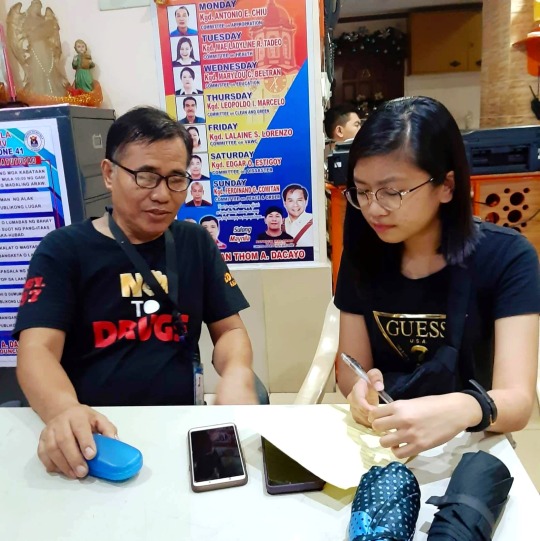
According to the notes given to us in our NSTP course, hazards are “any phenomenon, substance or situation, which has the potential to cause disruption or damage to infrastructure and services, people, their property and their environment.” Knowing how anyone can be subject to danger no matter where they reside, I had Kagawad Edgar identify the hazards that had been present in our community—Brgy. 397, Zone 41, Sampaloc, Manila.

According to him, the heaviest calamities that had hit the barangay were typhoons Ondoy and Piping. He referred to these as the worst as he recalled how the barangay was in deep flood for hours due to heavy rainfall and winds. The streets surrounding the community, especially España, weren’t fully developed as the drainage systems weren’t functioning well. These changed when a mega dyke was built in Blumentrit to mitigate the situation as told by Kagawad Estigoy. Another hazard that had hit the barangay, but fortunately has not affected it much, were the earthquakes. To be more aware or cautious about these things, he mentioned that we are already living in the age wherein Information Technology is very accessible and prevalent. This helps the council be on the lookout for incoming calamities. Indeed, the term “high tech” has been familiar to us, and this has paved the way for people to communicate and disseminate information easily. Aside from this, Kagawad expressed that there are organizations involved in providing people information like the Bureau of Communication Services, National Telecommunications Commission, and PAGASA. They also have what they call a “Public Address”, barangay tanods that roam around, and volunteers to help spread info. Basically, they become aware of an incoming disaster when they get the “nationwide notification” or warning; they, then, notify the residents of the barangay. What probably is a good thing amid all the disasters is how the community is not badly affected no matter how often these come. To give examples, Kagawad Estigoy cited how the recent typhoon Tisoy came yet the worst we’ve experienced out of it were heavy rains and strong winds that thankfully didn’t come to the point of destruction compared to the regions that had to go through being badly damaged like Isabela, Cagayan, Mindoro, Albay, Bicol, and Leyte (as cited from the interview).
When it comes to assessing people at risk in the community, the ones who fell under the most vulnerable to hazards were those who were near establishments made out of wood, which were the areas that were also considered the most dangerous within the community. This is because wood can easily catch fire which--something that cannot be easily put out. This kind of establishments would also be easily “washed out” by floods and destructed by winds. But in the community’s case, very few infrastructures are still made out of wood as most (within the streets of Moret, Galicia, P. Noval, and Tolentino) are already concrete.

According to Kagawad Estigoy, in times of disasters, those who will be largely affected would be the workers or “mga taong naghahanap-buhay”. He said that we cannot be sure with the financial stability of anyone and meant that not everyone has jobs that can sustain each day which can be affected with a single hit of a storm. Despite this, in terms of vulnerability and facing calamities, the interviewee said that the residents are not really affected to the extent that services will run out as the people are always willing help each other out, as well as give or donate resources. On the other hand, the safest place that can be located within and near the barangay were the open spaces and evacuation areas in the Paaralang Juan Luna and the field of University of Santo Tomas. Kagawad also added that the concrete establishments that surrounded the barangay were informed to be open and accessible to all to be evacuated in during emergencies, especially the building wherein the Chairman of the barangay resided. He said that they were tasked to give way to those who badly needed help or shelter and not be selfish with space. So far, there isn’t an existing problem that the barangay is facing which prevents it from being a better community to live in or from rising up again because in the first place, the fall is already prevented.
In assessing the capacity and disaster management, the council of barangay 397 equips itself and the community with supplies that is ready to use in times of dangerous situations. These evacuating tools include first aid kits, wood cutters and saws (incase of situations that would require removing big obstacles like trees that would fall on cars or roads), machines, ropes, emergency vehicles, and more. The council also makes sure to disseminate information to the community when there is an incoming danger. To help the people be prepared for any disasters, activities like fire drills and earthquake drills are conducted for the safety and awareness of everybody. The barangay council, community volunteers, and support from NGOs all help in the protection and preservation of peace and safety of the barangay.
My Community Walk
After gathering information from Kagawad Estigoy, I took a community walk to assess and check if the data I have accumulated matched the barangay’s situation. Below are what I have captured with regards to the hazardous areas, safest places, and best practices around the community.The hazardous places or spaces that I have captured included (1) infrastructures made out of wood since, as the interviewee had mentioned, it could easily catch fire and is feeble enough to be destroyed by strong winds and floods,
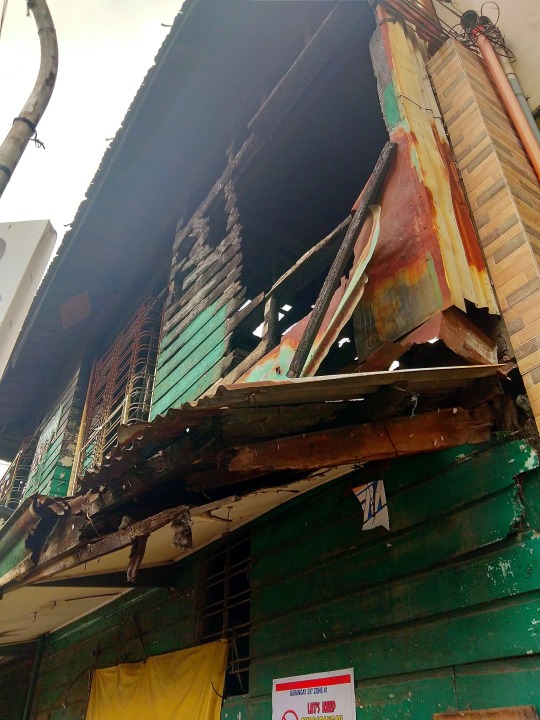
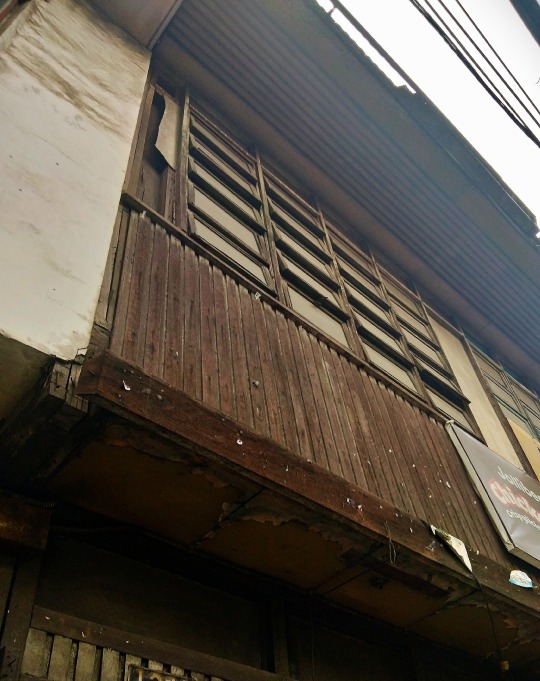

(2) sidewalk and road blockages/damages that have no proper warning signages which could put people in danger such as making them fall, trip, or are simply being obstructions,
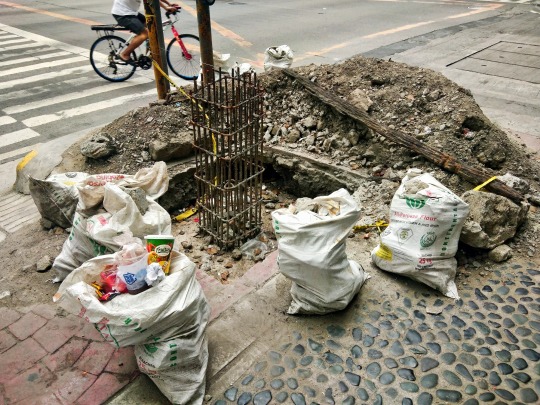
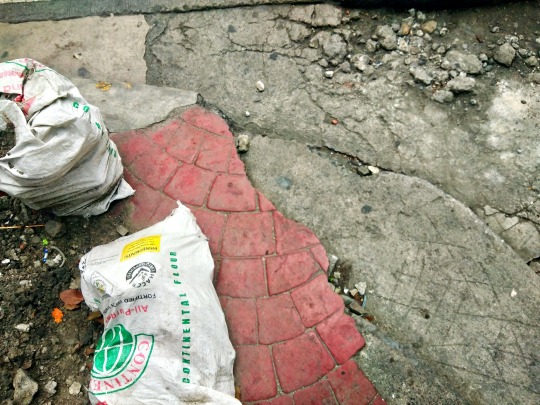

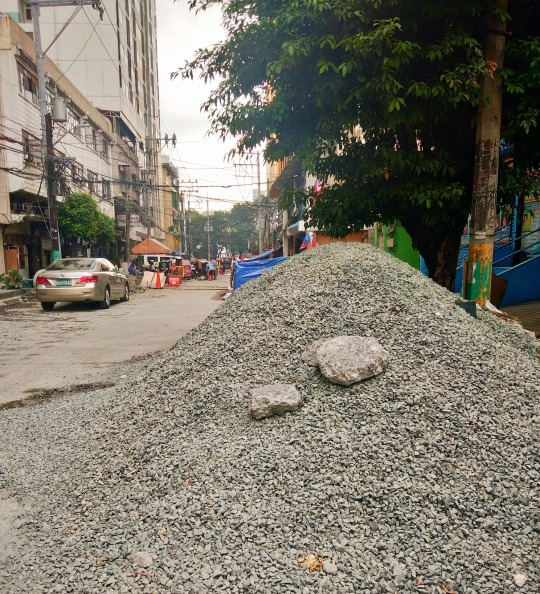
and (3) open construction sites that are too close to roads and establishments that is hazardous for many passersby that do not have PPE (Proper Protective Equipment).
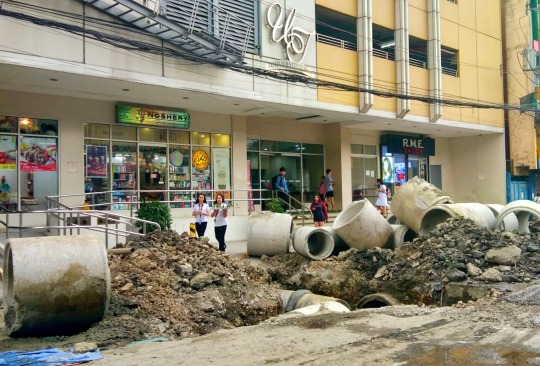

Some issues I have noticed were (1) the presence of too many electrical wirings that were all messily looped together which can be a cause for fire

and (2) the presence of heavy-duty equipment near construction sites that were just lying around unsecured.
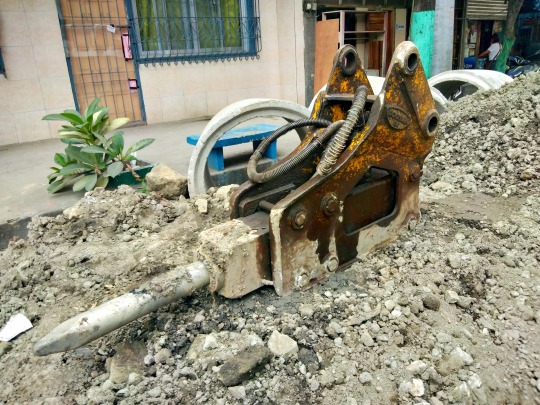
A hazardous practice I have captured is the construction workers act of not wearing PPE’s while working which could harm them while they do their jobs.
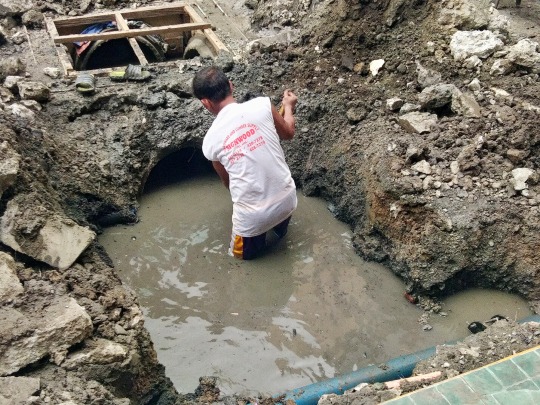
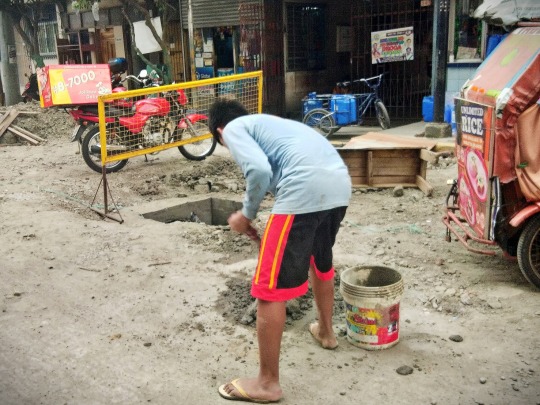
The safest places, as mentioned earlier, are the (1) UST field,
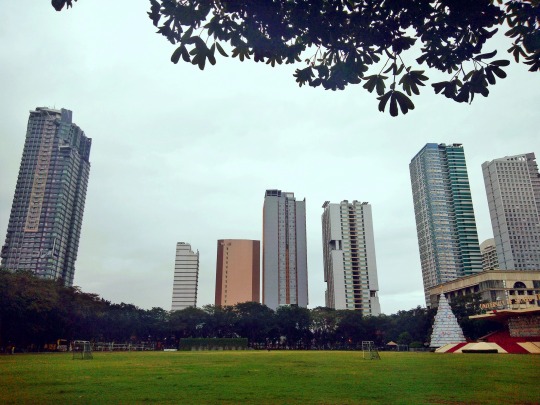
(2) Paaralang Juan Luna,
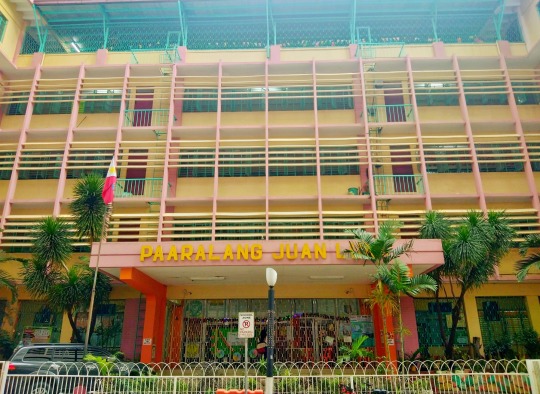
and (3) the barangay hall itself which is also where the barangay chairman resides.
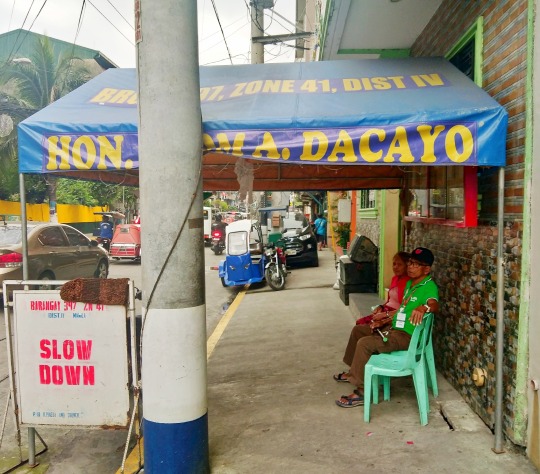
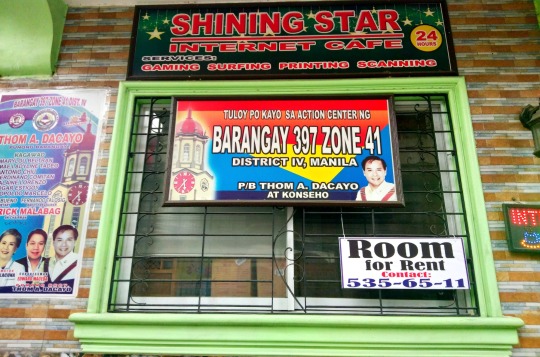
Last but definitely not the least, some best practices I have witnessed in the entirety of my community walk were (1) the proper segregation of waste (as there were trash bins in almost every corner in the community) and designated areas for recyclable materials,
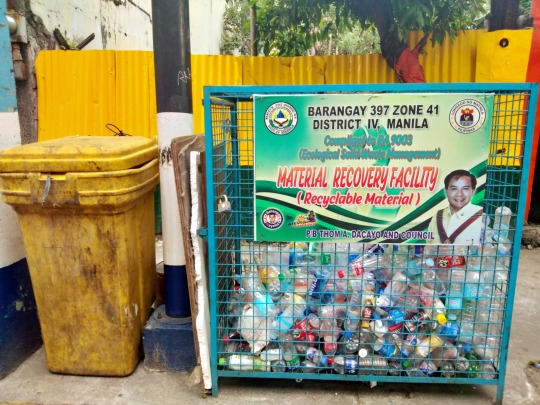
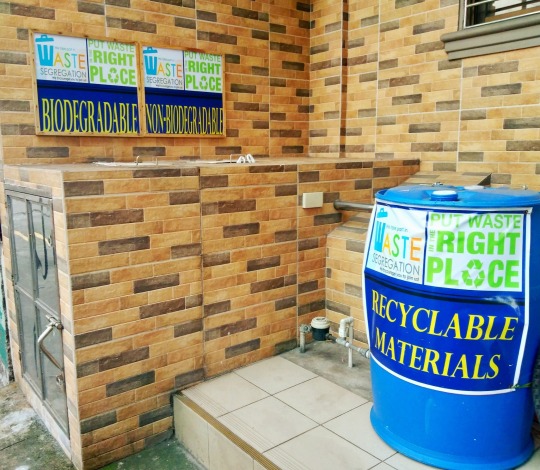
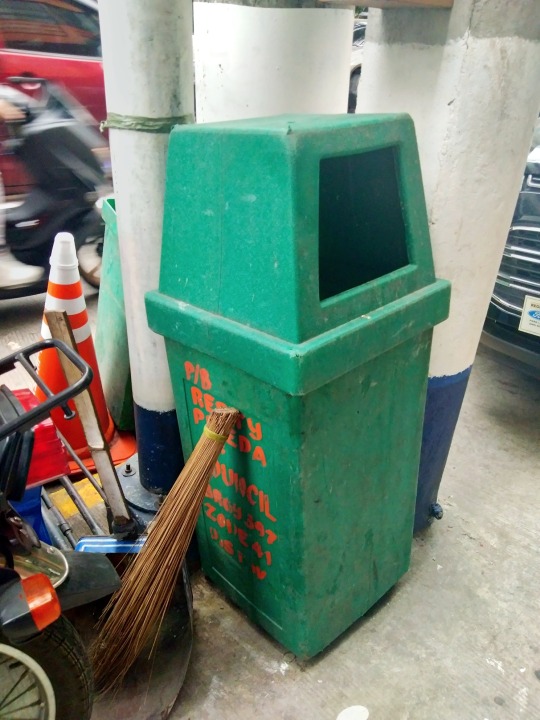
(2) the presence of many security cameras (for proper surveillance) and a warning horn (for important announcements),

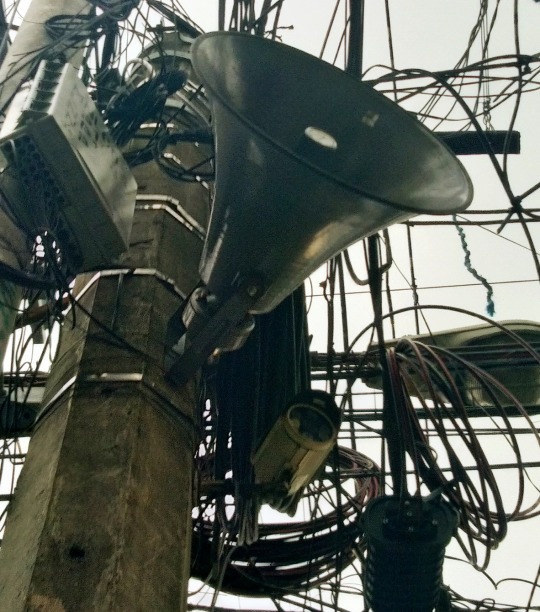
and (3) ready-to-go barangay vehicles that were provided for disaster response.
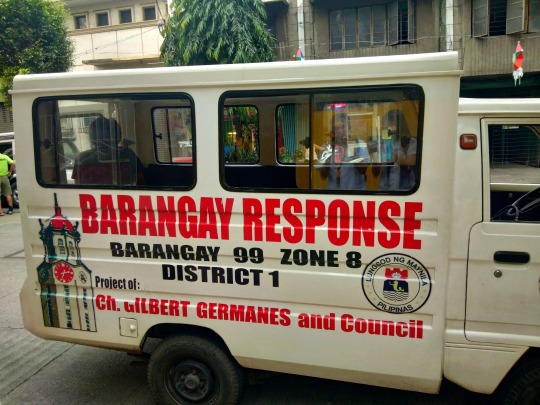
Because of the interview and community walk, I couldn’t help but also notice the issues that can be perceived to be small but can have a lasting effect. An issue I found confusing was how the barangay was missing a DRRM plan, which although crucial, seemed to be taken for granted since I was told there wasn’t really a need for it because the plans were all connected and “programmed” anyway in the council; that they were simply wired to be informed already. Another issue fell more under how the people don’t really follow the rules set out for them and their common good, even in the simplest things like proper waste disposal and taking segregation bins for granted. Pieces of trash can still be found scattered around the area despite having been provided with trash bins. These, in my opinion, are issues because it can affect everyone residing in the area and can be a cause for a domino effect that will gradually build up in the long run (ex. being a big factor for floods and health issues).
The mere fact that people continue to be careless despite being provided with a chance to come up with a solution (programs/plans) or have a solution (trash bins) right before their eyes tells something about the discipline that is lacking within the masses. This also influences people to go on with their misdeeds. This does not only apply to this particular community but to the whole country as a whole. It reflects the lack of effort of the citizens to do the simplest things to contribute to the betterment of other people and the environment. This is why change hasn’t come, and why a lot of bad things prevail in the country; because we can’t even follow something simple due to being undisciplined and careless. We need to be able to address this because people don’t even realize that due to these, more and more add up to being under the vulnerability list.
To increase the capacities of a community, it needs to start within the individual. The practice of thinking of the welfare of others should always be put in mind because as long as we care and live for the common good, there is hope. Perhaps, what the local government can do about it is conduct seminars and put up more infographics that are eye-catching will actually have an encouraging effect to the audience—activities that will leave a mark which will be remembered for a long time and can be taught by the elderly to the younger generation. Also, the local government can have somebody assigned to conduct a monthly check of the community area. Information can also be disseminated online to make use of the cyberspace where influence is strong and where almost everybody can be involved. But, all this cannot be possible if discipline isn’t present and maintained. There will not be grace amid disasters if people do not actually learn from what they did wrong which contributed to the worsening of a situation that eventually leads to a disaster.
1 note
·
View note
Text
Welcome to Brgy. San Isidro!
My Barangay Disaster Risk Reduction Management (BDRRM) kwentuhan with Mr. Benjamin Canillas Jr., assistant to the secretary, was conducted in the pleasant afternoon of December 6, 2019. We discussed about the disasters that can happen in Barangay San Isidro of Cainta, Rizal. I realized that there are disasters in the barangay that are highly preventable, it is just that people are lacking discipline. There may be shortcomings on the part of the local government, but we should also take the initiative to not let disasters happen. Because they are natural disasters, they happen on their own and will affect everyone so it is inevitable that we should plan ahead according to our living conditions to minimize the risks disasters bring with them. My walk around the community with my mother is a good way to conclude the discussion. There I realized that the government and the people really need to team up for the betterment of the barangay. It should be in the government’s best interest to make safety a top priority even before catastrophes happen. After all, it is called Barangay Disaster Risk Reduction Management because it is a management that reduces risks from disasters in a barangay. So to the residents of Barangay San Isidro, and to Filipinos in general, I hope this blog becomes of great help to you to ensure your safety and your barangay’s too in times of calamities.
Barangay San Isidro, in Cainta, Rizal, covers a land area of 2,158.9 hectares. It is about 6 kilometers from the center of Cainta where there is the balcony of the town. In the east there is the Barangay Mayamot of Antipolo City. In the west, Barangay Sto. Niño of Marikina City can be found. While in the north, it is bordered by Concepcion II in Marikina City and in the south one can find Barangay Sto. Domingo, also in Cainta, Rizal.
Creeks that easily get overflowed when it rains pose a danger of flooding. We have complete and working drainage canal but since such creeks are full of garbage, this a reason to invite floods in our area. Aside from lack of discipline from the residents, not having proper garbage disposal places contribute to the clog-inducing garbage. Floods affect the livelihood of people and those that live in low-lying places. During storms, our barangay relies on PAGASA for weather updates so we can prepare accordingly. It is crucial that our barangay be one of the first to know because our barangay is in Cainta, a low area, making it a catch basin of flood water from the high-lying grounds around. As everyone knows, earthquakes can’t be predicted so no early warnings can be disseminated to the community. But since we are located near the Marikina/Valley Fault System, we can be affected in case an earthquake stems from this fault line. It also happens that the soil where our barangay stands is soft. Soft soils amplify ground shaking. If one lives in an area that in past earthquakes suffered shaking stronger than that felt in other areas at comparable distance from the source, he is likely to experience relatively strong shaking in future earthquakes as well.
Here is a table included in Barangay San Isidro’s BDRRM Plan that shows how vulnerable it is to the disasters it can experience.

Twenty percent of houses in the barangay are made from light materials, making their inhabitants easily lose their homes even if a disaster is relatively low impact. Forty percent of houses here are close to the neighboring house, touching each other’s walls. This presents a problem during earthquakes where there can be a domino effect of casualties in the entire neighborhood. People have few alternative livelihoods here so it would be difficult to get up again after a disaster when one cannot utilize other forms of livelihood in case he can’t go back to his own for a temporary amount of time.
We have an Early Warning System (EWS) that according to the BDRRM, is easy to understand by the residents about what disasters are about to come. We even have an EWS for PWDs and other vulnerable groups such as children and senior citizens. The popular Filipino trait, “bayanihan system” is very evident in our barangay in times of great need because we go out of our way just to help others so everyone can be given their physiological needs and social support too. We listen to our barangay officials and persons of authority so we know what to do before, during, and after a disaster. The barangay officials enforce the Manila Clean-up Drive which happens every Saturday in all creeks of the barangay. This is a good way to reduce the level of flooding when it rains. But because there are people who need to know discipline, creek cleaners are always greeted by a new batch of trash every Saturday, signaling the need for stricter policies in the community.
Our barangay has safe spaces and people who aid in achieving safety. We have 13 covered courts or gymnasiums, thereby promoting the importance of physical health as it an asset in times of disasters when physical strength aids in survival. We have 1 multi-purpose building that can house relief goods before they are given away to those in need. There are 22 evacuation centers and in addition to that, there are barangay halls and 9 public schools that can be utilized as temporary shelters for the victims of disasters especially flooding. We have 1 private hospital and 4 barangay health centers that can accommodate those who are injured or in critical condition when disaster strikes. They can provide medications for leptospirosis in times of floods and for the injured when raging waters carry with it things that can hit and wound a person. For safety from the disaster itself, there are 5 trained emergency response teams in our barangay, and 10 trained BDRRM operations center and trained personnel. The houses of informal settlers pose a danger to the informal settlers themselves in times of storms when the strong wind would blow away their light-weighted houses, becoming a threat to them in losing their shelters and a threat to others who might get hit by the drifting materials. Creeks also pose a danger when they overfill and cause flooding because of their clogging garbage.
It is apparent that Barangay San Isidro needs help when it comes to storms, floods, and earthquakes that’s why the local government has taken steps to address these issues. There is always room for improvement and because the barangay still experiences high impact from disasters, the local government can improve and implement policies. The clean-up drive, for example, can involve the whole community so we can see the true state of our creeks and then there would be lesser or no more littering the next time the clean-up drive will be held. Housing projects can be implemented for the informal settlers because houses made from light materials can easily get blown away by the strong winds of storms. Not just for lessening the number of casualties, but such houses are also a sign of kindness from the government. For now, earthquakes cannot be detected so we should be prepared anytime. Infrastructures should be the focus of the government when it comes to this to somehow reduce casualties because the land where the barangay stands is a soft soil.
It is always good to learn more and be aware of the disaster situation of the country, not just my barangay. Storms can greatly affect my barangay because some have poorly built houses. In the whole country, informal settlers are rampant and an issue. It is hard for them to recuperate their homes after a storm. Even with assistance from the government, life will never be the same for a family to go and find another home even if they are used to it, being informal settlers. The country has issues with proper garbage disposal, just as my barangay has issues with it. Flooding now becomes a problem even with just rains brought by southwest monsoon or Habagat. The typhoons that habagat brings, unfortunately, cause millions, sometimes billions, worth of reconstruction damage and kill hundreds of Filipinos. Earthquakes are a concern of our barangay because of its proximity to a fault line. The whole country itself is cautious about earthquakes because it is located in the Pacific Ring of Fire. The majority of Earth’s volcanoes and earthquakes take place along the Ring of Fire. Ninety percent of Earth’s earthquakes occur along its path, including the planet’s most violent and dramatic seismic events. Being in the Ring of Fire, extra vigilance is expected from residents of Barangay San Isidro and citizens of the Philippines.
Disasters. We know about them. But why do we need to? We need to know about them because it is part of reducing losses acquired from them. When you know what a flood is, when and how it happens, you are pretty much equipped when an actual flood affects you. When you also know the preparations that have to be made, the actions that you must take up when the waters come raging, and the plans on how to recover be it for your shelter or livelihood, you can survive floods with minimal risks experienced. The same process goes to all the other calamities that can occur out there. Keep in mind that it is always better to be prepared than suffer the consequences.
Looking at a larger scale, the country should address the disasters it is experiencing. But how? Policy makers can make sure that risks are lowered through making laws that are targeted towards the prevention of disasters. For the people, prevention can be in the form of conducting seminars, handing out prepared kits to be used during disasters, and clean up drives that involve the whole community that instill a sense of discipline so they can know the state of their place and be more cautious the next time they do something, such as disposing of trash improperly, that can lead to disaster. Ecobricks can be made from trash and it also helps the homeless too for they can be used to build houses. An ecobrick is a 500ml to 1.5L sized plastic bottle tightly filled with plastic trash until it becomes almost as hard as a brick. For the surroundings, the creating or reinforcing of infrastructures can be utilized. Drainage canals are, well, for draining flood water, but they can’t do so if they don’t pass architectural and engineering standards. For the environment, policy makers should see to it that trees are utilized. Trees can reduce flood water by up to 20%. It may not be much, but it definitely helps. Besides, trees have other benefits such as providing clean air and adding to the aesthetic value of a place. We can have more trees around us if each one of us plants some. Not all seedlings become trees and so it greatly helps if everyone takes part in this so we can have a significant contribution to the environment.
Here are planned activities for the tree-planting activity and ecobrick-making.
“Flooding is preventable. Through trees, it’s feasible!”
1. Schools can organize tree-planting activities for students. Since it takes a long time for trees to grow, the next batch of students should take care of the planted trees and at the same time, plant their own trees.
2. Social media influencers can be tapped to create their own “challenge” regarding tree-planting so their followers can be motivated to participate.
3. Whenever one passes by a plot of land with seedlings or saplings, he must water them as he sees it fit.
“Houses made from rubbish. Don’t be fooled, they’re sturdy!”
1. The creation of ecobricks. People are to bring them to drop off points for ecobricks where they can earn certificates and tokens after reaching a certain amount.
2. People can post on social media the ecobricks they made and make it a competition about who can make the most in a month.
3. Houses made of ecobricks will be erected for the homeless. Other structures can be built too but the creation of such houses is the top priority.
References
Harrabin, R. (2016, March 11). Tree planting 'can reduce flooding'. Retrieved from https://www.bbc.com/news/science-environment-35777927.
National Geographic Society. (2019, April 5). Ring of Fire. Retrieved from https://www.nationalgeographic.org/encyclopedia/ring-fire/.
Scotty’s Action Sports Network. (n.d.). The two seasons in the Philippines: Amihan and Habagat. Retrieved from https://www.divescotty.com/underwater-blog/amihan-habagat-monsoon.php.
U.S. Geological Survey. (n.d.). Soil Type and Shaking Hazard in the San Francisco Bay Area. Retrieved from https://earthquake.usgs.gov/hazards/urban/sfbay/soiltype/.
1 note
·
View note
Text
Why You Need An Emergency Kit For Your Car
As your automobile gets older, things that have inevitably break down. No matter how diligent you are about preventative maintenance, the unexpected happens.
Whether you get a flat tire, and alternator goes out, or something more catastrophic like a transmission, odds are you will be stranded at some point as either in driver or passenger.
So when should you be concerned that your automobile is starting to become a liability?
According to an article by Shashank Nakate of Weelzine, an automobile resource blog, the average lifespan of a car is typically calculated by the number of miles a vehicle has been in use. Additionally, he notes that:
The average lifespan in general is between 165,000 and 200,000. As per the US Department of Transportation, on an average, automobiles have a lifespan of just over 13 years. Read the full article here...
While there are several factors that can contribute to this, here are the most common:
Use and number of miles put on the vehicle. This is a no-brainer, as you put on more miles, the automobile will naturally start to wear down due to general use.
Individual driving habits As any automotive expert will tell you, easing into your acceleration is much better for your automobile than just "gunning it." Additionally, slowing down gradually is better for your braking system, rather than sudden stops. Improving general driving habits will prolong the life of your car.
Preventative maintenance and upkeep. Making sure your fluids are topped-off, tires are properly pressurized, and that you're keeping up with the recommended factory maintenance will have a positive impact on the lifetime of your vehicle.
How To Create Your Own Roadside Emergency Kit
Now, before you jump on Amazon and start purchasing an emergency roadside kit, you may already have several the items in your possession.
Some essentials, such as bandages and a blanket or some of the first items to be included in your kit. An additional set of clothes as well can be helpful.
Edmunds.com has this to say about creating an emergency kit for your car:
When assembling your emergency kit, keep in mind that it should be tailored to the age and condition of your vehicle, your driving patterns and the weather. If you live in an area with no snow or freezing rain, you can skip some of these items. Also, if something on this list is inexpensive and small, you might as well carry it. You never know what kind of situations you might have to deal with.
As a general rule of thumb, being prepared is the best was to ensure you’re not stuck somewhere and a bad situation turns into a worse one.
And such, it's important to make sure that you have in emergency roadside at all times in your car. This kit should include vital necessities, and should be thought of as a survival tool kit.
Keep your emergency kit dry
As any survivalist will tell you, "keep your matches dry." Competitive survivalist, Ryan Dotson echos this sentiment as he reviewed a hard sided case from S3 cases:
I had noticed that the S3 website states that the cases are “water resistant,” but that each case should be tested to determine if it is actually watertight. I had to assume that a case with a pressure valve would be watertight, so I decided to test it. Tissue paper is an excellent gauge to determine if moisture has penetrated a case. Even one drop of water will greatly affect the appearance of the paper. I placed a single piece in the 5000 case and closed it up. I twisted the pressure valve tight and headed out to our pond.It was time to get wet. I attached the cord from our boat anchor to the handle of the case and climbed down to the edge of the water. I threw the anchor and the case into the water and held onto the cable. The water level was a bit low, so I had to splash it around a bit to get the whole case wet. I was sure to get the seal line down below the surface of the water, so it would try to work its way inside. After playing in the water for a minute, I pulled out the case and dried off the outside. I popped open the latches and opened up the case. The paper was completely dry. If I decided to put my first aid kit or fire building supplies inside, I knew they would stay dry in the wild.
youtube
Summary
An emergency kit is a must for any automobile. Whether you're purchasing a kit online or building one yourself, it's important to make sure that you think about survival essentials. Your life may actually depend on the contents of an emergency kit should your car break down.
Additional Resources:
Having a Go Bag Ready
Emergency Car Kit on Amazon (Disclaimer: This is NOT an affiliate link. It's meant purely as a resource for those interested in learning more about emergency kits for their car)
Tips That Could Increase Your Car's Lifespan
1 note
·
View note
Text
Everyone should have a first aid kit.
I recently discovered that a fairly high proportion of people I know do not have a first aid kit in their homes, and this is horrifying to me. Please, if this is you, rectify this situation.
This is not justifiable on “I’m unlikely to accidentally cut my arm off so I don’t need bandages” grounds. Not all emergencies are unlikely events played up by alarmists; heart attack is the leading cause of death across the developed world, kills 1 in 4 Americans, and is significantly more survivable if you have aspirin on hand. (If you suspect someone is having a heart attack, priority 1 is call an ambulance, priority 2 is give them aspirin. Time matters in those situations; it is worth having it quickly accessible in a cupboard, and more obviously worth it the older you are.)
This is not justifiable on “I’ll just buy medicines when I get sick” grounds. When you wake up at 6am vomiting with a killer headache, you may not be particularly thrilled by the idea of driving to the store to buy medicines. So prepare in advance. I guess you could rely on other people driving to the store for you, but why would you defect when you could instead be pro-social?
In any case, you may not be able to go to the store in all situations. When I fell off my scooter and took all the skin off my knees, it was past midnight in the outskirts of Cambridge, and the nearest open store was 40 minutes’ walk away. If I hadn’t wanted to walk for 40 minutes while every step hurt, I would have had to wake someone up in the small hours of the morning to ask for help. Luckily I had antiseptic and plasters in a cupboard so I just cleaned myself up, solved the problem, and went to sleep.
This is not justifiable on “but if it’s minor then it doesn’t need treating, and if it’s major then I should go to a doctor instead of treating it myself” grounds. A first aid kit is how you know whether it’s minor or major. There are plenty of collections of symptoms which are fairly minor on their own, but if you also have a high fever then you should go to the emergency room. If you don’t have a thermometer, you don’t know whether you have a high fever. There are also plenty of situations where you can take a basic remedy for X, and then if it doesn’t clear up, you have evidence that it’s something more serious than X and so you can choose to go to a doctor at that point.
This is not justifiable on “I rarely get sick” grounds. Medicine isn’t about individuals, it’s about being pro-social and cooperative. The important part of getting a vaccine isn’t that you personally won’t get sick, it’s the herd immunity you’re contributing to. If a friend is visiting you and realises they feel a migraine coming on and they left their meds at home, and you are able to offer them ibuprofen, you will be able to save them lots of disutility for very little cost. Inviting people over when you do not have a basic medicine cabinet is sort of like inviting people over when your house doesn’t have running water.
A basic first aid kit should have:
Aspirin (note: do not give to children)
Antiseptic in some form (wipes, gel, whatever)
Plasters / a bandage
Ibuprofen gel, or a similar skin-absorbed local anaesthetic (mostly good for pulled muscles, which are a common exercise injury especially among people who don’t stretch much, and which can be surprisingly painful - verging on paralysing if your pain tolerance is low)
Ibuprofen
Paracetamol, aka acetaminophen (alternative painkiller for people/situations where aspirin/ibuprofen are bad ideas)
Oral antihistamines if they’re available in your country (these are not enough to handle a severe allergic reaction on their own, but will help if hayfever is causing puffy eyes or mosquito bites are getting to you)
Hydrocortisone cream/gel (usually OTC in low concentrations for applying to skin - it’s for itches and rashes, and it can help you tell whether a rash is a mild allergic reaction or a sign of something more serious)
Some kind of antacid (good for heartburn/indigestion, and for distinguishing heartburn/indigestion from more serious pain)
Sunscreen, and after-sun burn cream
Activated charcoal (for poisoning, overdoses, vomiting, and idiots who eat Tide pods - note that it fucks with basically all medicines)
Cold or flu medications - look for decongestants, cough suppressants and throat soothers
Energy drinks (or proper rehydration stuff if you can get it) - the sugar and electrolytes are really important when rehydrating people (which is important for a whole variety of situations, from diarrhoea to alcohol poisoning)
The morning-after contraceptive pill
If there are any anti-anxiety or anti-panic-attack medications which are legally available in your country, get those
Sterile distilled water in sealed containers (for cleaning stuff, especially your eyes), ideally drop containers so you can use it as eye drops
Thermometer
Tweezers
Cling film (aka plastic wrap / saran wrap), tape and scissors (but you don’t necessarily need to keep these in your first aid kit, so long as they’re somewhere in the house)
Synthetic gloves (ideally not latex)
This definitely varies depending on what kind of area you live in, and what kind of social circle you interact with. If the people around you are the kind of people who are at risk for drug overdoses (I’m looking at you, Bay Area friends), it is more important to have kit to deal with that. If you have kids, you may need child-safe variants of some medicines. I do judo, so I have extra stuff to deal with sprains and muscle injuries and mat burn. It’ll also vary based on what’s legal - Naloxone is illegal in most places, but I’d endorse having it if it isn’t (it saves people from opioid overdoses). If you live in an area where natural disasters happen regularly or you might get snowed in, you probably know more about it than me, but you should have an emergency kit with food and water and maybe a generator or something.
If you own a car, you should have a first-aid kit in your car as well as in your house. This one can afford to skip a lot of the medicines (and the painkillers, which untrained on-the-scene people shouldn’t really give out), but it should specifically include scissors and tape and a box of tissues, because you won’t necessarily have those in the car the way you’ll have them around the house. Also, it should have a warm blanket, water bottles, and a flashlight. You may consider adding a first aid manual, because not all car crashes will conveniently occur in an area where you can get 3G and look up first aid stuff online, and some car accidents might destroy your phone.
I am not a doctor, and you should not treat this post like it is doctor advice. I also disagree with much of the advice available on the internet; many lists of first aid kit stuff include things which are useless to the average person. I do not know the difference between a gauze pad and a cotton bandage and a triangular bandage and I am not going to be able to pick the correct one, so there is no point in me having all three.
Many first aid kit lists also don’t include things like morning-after contraceptives, because...? Why the hell do people think that it is worth stocking up on plasters in case you get a papercut, but not worth having emergency contraceptives in case you have unsafe sex? Some of them do not include rehydration stuff or activated charcoal, like... if I was being uncharitable I would blame this on the War On Drugs philosophy of just letting people horribly die because they did the eeeevil action of accidentally ingesting something they shouldn’t, or something in quantities that they shouldn’t. Not that you even need to be doing illegal drugs or even low-status drugs in order to get a dangerous overdose, I’ve totally accidentally made myself sick drinking too much espresso because I was trying to be a good servant of capitalism and get plenty of work done. Ordinary non-medical-professional people’s first aid kits should not be for play-acting superhero with a dazzling variety of cool wound dressings, they should be for helping actual humans.
Anyway get yourself a first aid kit, and stock it with stuff actually likely to be useful to you and the people around you. Aspirin and hydrocortisone and charcoal, not gauze pads and complicated wound dressings and sewing needles. And then restock it when you run out of ibuprofen, or when stuff expires.
352 notes
·
View notes
Text
The Pros and Cons of survival products
The Ultimate Guide To How To Put Together The Ultimate Survival Kit?
youtube
Understanding this, what to include on your survival set list as well as carry in your kit can literally imply the difference in between life as well as death in simply a couple of critical minutes or hours. Fortunately is, you can significantly raise your opportunity of survivalif you have the right materials with you (and understand how to utilize them).
In concept, the extra crucial survival products you carry with you, the easier it will be to survive Nevertheless, the flip-side to that is the extra products you include on your survival package listing, the extra bulk/weight you contribute to your person. Certainly, you can not lug every wild survival device you encounter as it would quickly end up being difficult to transport them all.
But that said, there are some core survival basics that you should constantly have offered in your survival set. Right here's my tackle 13 important survival things you require to load (consisting of a pair truly important incentive items to think about): Starting a fire in the wild is among the most vital points you require to be able to do if you're to survive the cold, combat starving predators and cook yourself a meal.
This is where a trusty fire starter comes to be the top essential survival item to carry you whatsoever times. As a matter of fact,. You should not take chances with fire starters. I carry matches, a bic lighter and a striker. Supplement this by loading some tinder and also other illumination aids such as InstaFire Fire Starter, also.
Not known Details About What Is In An Emergency Survival Kit?
Opportunities are, you will certainly need to do a great deal of reducing duties in a real survival circumstance, as well as a good, trusted survival blade will certainly be a perfect fit. Select a high-quality survival blade or a multi-purpose device with a knife. Your survival knife must have the ability to skin your search, reduced strings, and also sharpen sticks among various other uses.
The exact same concept of redundancy applies here too. "Where there's two, there's one where there's one, there's none." Should your knife fail you or you shed it, you'll absolutely want a trusted back-up. Take a look at the Ka-Bar https://www.rawstory.com/2013/08/california-school-district-preps-for-more-lockdowns-with-1800-plastic-classroom-toilets/ Becker BK2 for a fantastic, full tang knife that will last. You ought to not count exclusively on GPS when in a survival situation, yet additionally lug with you a local map as well as compass to assist navigate your way back to security.

These are lightweight and also simple to pack, so there is actually no reason not to carry these with you in your survival package. Having a map and a compass is one point, however, you must likewise take the necessary actions to understand just how to read and also browse maps and make use of a compass.
In instance you don't have a compass, Suunto makes a terrific one. If you think you may require to head into the wilderness at a moment's notification, make certain to have a first-aid kit on your person in all times. An emergency treatment package is a critical product that must come in any way times.
https://www.lamag.com/guide/health-medical/sos-survival-products/ >Some Known Details About These Items Should Be On Your Survival Kit List

General emergency treatment packages can be a great location to start however make certain to supplement them with such products as pressure dressings to quit the bleeding on the occasion that injury might happen. Experience Clinical Packages are a fantastic location to begin. Consist of a initial help pocket manual and acquaint yourself with it, especially if you aren't formally educated or experienced.
Make certain to pick a long lasting, light-weight steel framed saw. A bow saw can help you cut through logs as well as make firewood. It can also help you reduce down large branches to make a sanctuary https://www.hmc.edu/emergency-preparedness/emergency-preparedness/ that your survival knife may have trouble doing alone. If you take care of to shoot a deer or large video game, you will require to https://www.lamag.com/business-category/health-medical/ build a solid fire to roast your meat.
When you head into the wild, also on a hot bright day, you require to plan to dress for the worst. Hypothermia eliminates even more individuals in the wild than any various other reason. The cold of the night must not be responded to with fire alone, yet additionally proper apparel. Always layer your clothing, remembering to use loosened, split clothes with woollen as your under layer.
It keeps dampness that makes it less insulating, tougher to dry out as well as much heavier on the body. This has been recognized to bring about hypothermia, pneumonia, etc. Clothes constructed of synthetic and wool materials are recommended for this really factor. A plastic whistle kept around your neck is extremely advised simply in instance you get lost.
How Making Your Own Emergency Kit can Save You Time, Stress, and Money.
Plastic whistles are recommended as they are lightweight, float and will not corrosion. There are heartbreaking tales where search helicopters have overlooked lost people as well weak to signal. A signal mirror or heliograph ought to be lugged with you. Keeping it in your emergency treatment kit is an excellent way to safeguard it from damages and also find it quickly.
Rope is a typical name made use of to explain everything from a steel cord to a nylon string. Rope is among one of the most vital survival products when you require to climb high areas, drag game you have actually killed, connect packages of fire wood as well as far more. Rope serves many features like an angling line, cloth line, food line as well as much extra.
Titan SurvivorCord is a really special multi-purpose paracord used by Unique Forces and also comes very suggested for its range of uses. Couple of aspects can confuse even one of the most seasoned adventurer quicker than being shrouded in total darkness. If you plan to venture out right into strange area or discover on your own outside after dark, a trustworthy flashlight is a need to have in any kind of survival kit.

For among my favored flashlights, have a look at the Streamlight ProTac Penlight. Remaining in belongings of the above essential survival products is just one action in surviving an emergency scenario. You still require to understand how to utilize them efficiently. You need to be prepared in the very best method feasible to be able to make it through for days.
0 notes
Text

© AP Photo / Silvia Izquierdo
OPINION
Bolsonaro Gov't Pushing Brazil's Native Peoples to the Edge of Extinction, Indigenous Leader Warns
— 07.16.2020 | By Ekaterina Blinova | Sputnik
The Bolsonaro government has no interest in shielding Brazilian Indians from COVID-19, on the contrary, it has long sought to open indigenous lands for mining and agribusiness, considering native peoples to be only a stumbling block, notes indigenous leader Weibe Tapeba and Brazilian scholar Gustavo Guerreiro.
Brazil has become a new hotspot for COVID-19 second only to the US in the number of confirmed cases and fatalities. Even the Brazilian president, Jair Bolsonaro, who long shrugged off the danger of the coronavirus pandemic, tested positive for the virus.
Meanwhile, human rights activists are ringing the alarm over soaring fatalities among the country's indigenous population. As of 15 July, Brazil's Department of Indigenous Health Care (DIHC-DASI) registered 10,889 COVID infections and 218 deaths among Brazilian Indians, while the overall number of cases in the country mounted over 1.96 million.
Mortality rates among Brazilian Indians are almost twice the national rate (12.6% versus 6.4%), as Articulation of the Indigenous Peoples of Brazil (APIB), an advocacy group, found in June.
How Bolsonaro Gov't Exposes Brazilian Indians to COVID
"The indigenous peoples of Brazil have been vulnerable since the day the Kariwas (white man) set foot in our territories", says Weibe Tapeba, a Tapeba Indigenous People leader and legal advisor to the State Federation of Indigenous Peoples of Ceará – FEPOINCE.
Tapeba emphasises that the Brazilian government failed to adopt efficient measures to combat the spread of the disease in indigenous territories.
"The need to expand human resources, infrastructure ranging from the need to build basic health units and the provision of beds to the need for quick tests, food baskets and personal hygiene kits, would be fundamental in this pandemic moment", the indigenous leader observes.
There are only about 896,000 native Brazilians – distributed among 305 unique ethnic groups – in the country of 209.5 million. Given that many Amazonian tribe numbers are fewer than 1,000, the coronavirus pandemic is threatening to exterminate them.
"The indigenous people are, historically, an ethnic group marginalized by the Brazilian state. Public services are much more precarious in indigenous villages", states Gustavo Guerreiro, executive editor of the journal World Tensions and a member of the Brazilian Centre for Solidarity with Peoples and Fight for Peace (CEBRAPAZ).
While indigenous groups have shown a great commitment to maintaining social isolation and practicing self-protection, regular incursions of miners, loggers and illegal settlers into their territories have largely contributed to the spike in COVID-19 cases among Brazilian native peoples, according to the observers.
For its part, the country's Ministry of Health has yet to roll out a meaningful plan to combat the pandemic among indigenous tribes, Guerreiro points out. Having failed to stretch a helping hand to Brazilian Indians, the government is further exacerbating the situation, according to the scholar.
"In his most recent act, Bolsonaro vetoed several crucial points of a law that protects Indians during the pandemic", he says.
On 8 July, the Brazilian president vetoed provisions of a legislation earlier approved by the Congress which obligated the federal government to provide indigenous communities with drinking water, disinfectants and hospital beds amid the coronavirus pandemic. In addition, he turned down funding for the states and local governments envisioning emergency aid for native peoples as well as greater internet access for indigenous communities, which was meant to prevent them from travelling to urban centres. In justifying his decision, Bolsonaro claimed that the provisions were “against the public interest” and “unconstitutional,” as they created excessive expenses for the federal government.
"However, in a historic decision, the Supreme Court forced the president to take necessary measures to preserve and save the lives of the Indians", he elaborates, referring to the ruling by Justice Luís Roberto Barroso issued the same day, in response to a complaint from the Articulation of the Indigenous Peoples of Brazil and the country's six opposition political parties.
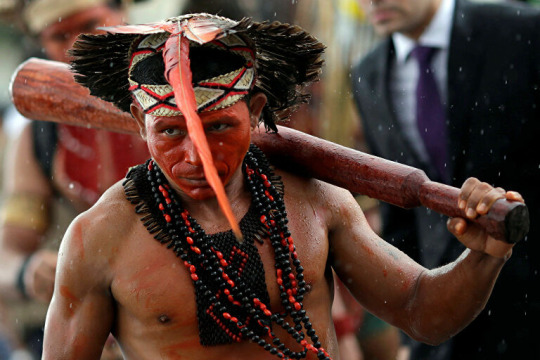
An indigenous man from the Pataxo tribe attends a protest of indigenous people at the entrance of the Planalto Palace in Brasilia
Land Demarcation Dragged Down & Stopped
Neither Weibe Tapeba nor Gustavo Guerreiro have been surprised by the Bolsonaro government's actions: according to them, it has been "anti-indigenous" from the start.
"The Brazilian government has the mark of structural racism, prejudice for ethnicity and of not recognizing cultural diversity in our country", argues Tapeba. "Still a candidate, the current president already categorically indicated that he would be at the side of agribusiness and that he would not demarcate any other indigenous land in the country".
"It is not just an omission or negligence", stresses the indigenous leader. "It is the materialisation of a power project that tries to exterminate us".
In August 2019, Bolsonaro was quoted as saying: "As long as I am president, no indigenous land will be demarcated. They own 14 percent of the national territory". On another occasion, the Brazilian president noted: "Indians are undoubtedly changing … They are increasingly becoming human beings just like us".
There are at least 610 indigenous lands claimed by Brazilian native peoples which are still pending government action, according to Tapeba. However, Brazilian local authorities, backed by farmers and agribusiness companies, appear to deliberately drag down the solution of the issue through lengthy administrative processes.
"The judicialization tactic has led to processes of demarcation of territories such as that of my Tapeba People, dragging on for decades", the indigenous leader says. "In the case of my Tapeba People, this process has been going on since the beginning of the 1980s and with no end in sight".
The land rights of indigenous communities were enshrined in the country's Constitution of 1988, which recognized them as the first and natural owners of the land, setting a five-year deadline to finalise the demarcation. However, 32 years have passed and this process has not yet been concluded, remaining at the mercy of lengthy legal proceedings and political pressure in the parliamentary sphere, according to Guerreiro.
"All government actions are directed against the continuation of the process of demarcation of indigenous lands, by environmental deregulation and the exploitation of mineral resources in their territories", the scholar notes. "Bolsonaro does not show the slightest respect for constitutional provisions and international treaties that aim to protect the Indians' way of life, their resources and their culture".

A young Pankararu Indian, in traditional dress, stands near a pitched tent at an encampment in front of the Brazilian National Congress building in Brasilia, Brazil, Monday May 2, 2011. A variety of tribal groups plan to camp out in front of the government building until Thursday, in protest against the construction of the Belo Monte hydroelectric plant in the Amazon rainforest.
Bolsonaro Defunds Indigenous Gov't Agency
Once Bolsonario assumed the presidency he tried to shut down the National Indian Foundation (FUNAI), the Brazilian government body establishing and carrying out policies relating to Brazilian Indians, which includes the objective of demarcating indigenous lands, Tapeba underlines.
The president's decree further envisaged taking away the responsibility for indigenous land demarcation from the FUNAI and handing it over to the country's agriculture ministry, a move supported by the agricultural lobby.
"The measures were materialized by means of an administrative reform decree, but it was reversed through a decision of the Supreme Federal Court (STF), which was once under pressure from several indigenous organizations and even political parties", the Indian leader says.
Bolsonaro did not give up, however, as, being unable to dismantle the body altogether, the president considerably slashed its budget, Tapeba notes, as well as acting to weaken environmental protection mechanisms in the country.
"The government's clear project is to open indigenous lands for the exploitation of mineral wealth, for agribusiness, for the implantation of large enterprises and to try to legalise what they call 'self-declaration' of property, facilitating a fraud in the titling of lands incident in indigenous territories", the indigenous leader warns.
0 notes
Text
Power Failure, What Causes Blackouts, and What to Do in a Power Outage

The wind is blowing hard, the rain is horizontal and it's freezing cold at 3:00 am a tree just fell onto the dining room side of the house, rain is coming in. Three trees have fallen across the only road to our side of the island, neighbors are out there cutting it up. My wife and I have grabbed our emergency kits and went to the levee, standing in the rain waiting for the word to be able to go into the house if there is anyone to tell us we cannot. All of the neighbors were out on the levee, a transformer on a power pole was struck by lightning and woke everyone up. Nothing has flooded or caught on fire, all of the houses are still standing, it's a good thing because the first responders are not able to make it to any of the houses on the island, the bridge is gone. With nothing else to do, everyone went back into their houses to spend the night, we may be looking at a morning without coffee.
We had been hit with a double whammy, a major earthquake during a driving rainstorm on a January night, the entire San Francisco Bay Area is crippled due to a major power failure. We have all most likely experienced a blackout, but does everyone know what to do in a power outage? I think probably not. Few people have gotten out of the city, the traffic jammed up on the Bay and Golden Gate Bridge's, the only way out for them was highway 101 south, it's a parking lot. We've got the family all over the country, we have discovered the entire state is affected from Fresno north, the epicenter was on a fault that was declared "inactive", it is a long fault running from Concord to Mountain view. Now some decisions must be made.
This never happened, could it, yes it could happen, we keep hearing it is a matter of when not if, so what are some of the actions to take? The first is Communications, as soon as possible notify your relatives and loved ones. Take the emergency preparedness plan out of the emergency kit that was put together in anticipation of this event. Included in that plan is a telephone number of a relative living out of the affected area. Choose a person out of the area as a contact, the local telephone lines will be jammed up, 911 calls are the most common. When we make a call if we get a "busy" signal normally we will hang up then immediately redial the same number, compounding the problem. The "recalls" add to the volume of calls crowding all of the calls out of the queue. Call the contact number every 4-5 hours if possible, however, after one call is made that you are OK it will be relayed to others calling the line.
Make a determination if you are able to remain in your home or if you must walk out, gather as much information as you can. If the house is structurally sound it will be safe to stay. Then secure the electrical, natural gas and water supplies, the water will be off as well due to there being no electric service. We will smell gas if a gas line is corrupted but we will not be able to detect a water leak or if the electrical system has been compromised, it could start a fire. It is safest to eliminate the worry, it will be a hassle after the utilities return because your supplier will have to check out the systems but it is the safest action to take. Standing water and an electrical short to ground to not compliment one another.
Water, check your supply, we need a minimum of 1/2 gallon per person per day if that much water is not on hand begin conserving immediately. Check the food in your freezer, part of the emergency plan should have included freezing water in your freezer. In many ways, this event can be defined as a freezer power outage as well. Using containers holding milk or juices fill them with tap water, place them in your freezer and leave them there. They will help keep the frozen foods cold for a longer period of time when the ice melts the water is drinkable. Container made for this purpose are readily available, mine are 1 gallon each, approximately 1-foot square and 2 inches thick, laid under all of the food they work well. Do not open the freezer door until you positively have to, if the temperature goes below 40 degrees and the food begins to thaw, the usable life of the food decreases. If the food itself drops below 40 degrees, it's time to throw it in the trash, don't chance getting an intestinal illness, we all know what misery that is. Stop using the toilet if there is no way to flush it if it is continued to be used we are heading for a huge problem. If there is water available, in a creek, lake or pond the toilet can be flushed by dumping a bucket of water (2 gallons) directly into the bowl. I suggest making a rule if you're the one that used the water you're the one to fill it again. A temporary toilet can be made by using a 5-gallon bucket, using a split swimming "floaty" as a seat, black garbage bags work well as liners. A commercial "porta potty" may be purchased at most camping supply outlets. As the water from the freezer and your supply dwindle, start making water, boil and purify, fill your containers.
Save the food in your evacuation kit for use after the food you have in your pantry has been extinguished, use as much food from your freezer as possible first. The spirit should be this event may last for two weeks or longer, I am a proponent of not just having a 72-hour emergency kit, but having supplies for one week, which means adding more food to a commercially prepared kit. If we have not received word on long the event may last, call the contact number, even though it's out of state they most likely have kept up with the ongoing event. Prepare for 3 days, but expect 6, it won't hurt a thing. Keep boiling water, charging cell phones with the dynamic charger (or your vehicle) and keep informed through the radio.
1/3 of the people are over prepared, 1/3 kind of prepared, and 1/3 completely unprepared. It's prudent to expect the neighbors to need water, prepare yourself to supply them. None of us will be 100% prepared, there are just too many unknowns and not everyone subscribes to the "self-reliant" life style, I think it's best to accept reality. Remember after the disaster they will still be your neighbors, I would not be able to refuse someone water if I have any amount. Make no mistake, water will be the number one sought after commodity, especially if a flood takes place. A big part of my mission statement is to be overly prepared, with the goal of my family and I being over prepared and in a position to help other people, that's the only way I would be able to look my self in the mirror. In times on hardship people band together and come to one another's aid, I've seen it happen many times. Most people want to be an active positive contributor during times of crisis, humans need each other for survival. The person contributing the coffee pot that first morning will gain the status of a mythical "god".
After the initial 3 days have passed and it looks like it may be an extended event we should be in pretty good shape. We have just started to notice the freezer defrosting, the ice in it is still solid, we conserved our food in the emergency kit by using the freezer and pantry food. In a few days, decisions will be made whether to throw freezer foods away, water production continues and responders are beginning to evacuate at risk people. Looking like the event may last a month or more, we are now in a long term situation, however, due to pre-planning and foresight, we will survive it.More about acotemporarypower.com
This is the first 3 days, it could be better and it could be a lot worse, we had some water on hand and a way to make more, many people won't. We won't be out of the mess yet, but we are surviving on our own, self-reliance and confidence paved the way. If you need to rev up your disaster preparedness planning, set up a commercially prepared or self-made home emergency kit. I would suggest a 4 person survival kit for two people, that will get them by 6 days, the length of time I feel is most logical. Most power failures are short lived, however once in a while, (more often than we may think) they last for a week or longer, sometimes longer than a month. What causes blackouts? lots of things, they are unpredictable, leaving all we are able to do is prepare for them in advance.
0 notes
Text
Wall Street Rises After Historic Plunge: Live Market Updates

Wall Street’s gains fade as investors’ jitters persist.
Stock climbed Friday, rebounding from their worst day in more than 30 years, with gains that were pinned partly to signs of movement in Washington and a pledge by leaders in Germany to spend heavily to support Europe’s largest economy.But investor nervousness persisted and an early rally on Wall Street faded. The S&P 500 was up about 1 percent by midday, after initially jumping as much as 6 percent. Trading in Europe followed a similar pattern, with major indexes surging as much as 10 percent early in the day before losing steam as the week ended.Financial markets have been nothing if not inconsistent for the past three weeks, plunging and then rising, and then plunging again, as each day brought new measures to contain the outbreak and new worries that the economy, workers and businesses would take a hit as a result of them.On Thursday, stocks on Wall Street and in Europe plunged in their biggest daily drop since the stock market crashed in 1987, as President Trump’s ban on the entry to the United States from most European countries disappointed investors, who had been waiting for Washington to take stronger steps to bolster the economy.But late Thursday, House Speaker Nancy Pelosi said that she and Treasury Secretary Steven Mnuchin had “resolved most of our differences” on a package of economic aid for workers and companies, pledging a vote in the House of Representatives on Friday.And on Friday, Germany’s government said that it would make more than $600 billion available to help companies there, while France pledged to unleash tens of billions of euros to prevent a potential jump in unemployment by paying small and medium-size businesses slammed by the epidemic to keep workers on furlough.Olaf Scholz, the German finance minister, said that his government could take further steps, including taking stakes in companies, if deemed necessary. “We can’t forget the lessons of the previous financial crisis,” Mr. Scholz told reporters in Berlin.Also on Friday, the Federal Reserve Bank of New York moved again to inject more liquidity in the Treasury markets, saying it would complete half of its planned $80 billion of government bond purchases for the month today.“These purchases are intended to address highly unusual disruptions in the market for Treasury securities associated with the coronavirus outbreak,” it said in a statement.The volatility in markets this week reflects the increasing concern that governments and central banks may not be able to meaningfully mitigate the economic fallout from the spreading coronavirus.Asian indexes were hammered on Friday following the U.S. market plunge. Like Wall Street, every major financial market in Asia except for China is now firmly in bear market territory.
The Fed will inject more liquidity into the Treasury market.
The Federal Reserve Bank of New York is buying up a variety of Treasury securities in a bid to keep markets functioning normally after trading in government debt broke down earlier this week — and that effort to help became even more substantial on Friday.The bank said it would pull forward its planned monthly purchases, which total $80 billion, so that half of them would be done by the end of the day. It would also “bring forward remaining purchases for this monthly calendar and adjust terms of operations as needed to foster smooth Treasury market functioning,” it said in a statement.The swift action suggested to some investors that there could be more to come, and stock prices rallied on the back of the announcement.“It’s a signal that they are diagnosing what it going on in the market,” said Julia Coronado, founder of MacroPolicy Perspectives. “It’s a signal that we’re likely to get quantitative easing next week, if not before.”But just as the Fed was pulling out the stops, President Trump was tweeting about the central bank’s inaction.“The Federal Reserve must FINALLY lower the Fed Rate to something comparable to their competitor Central Banks,” he wrote. “Jay Powell and group are putting us at a decided economic & physiological disadvantage.”The Fed was ahead of its global counterparts in reacting to the coronavirus’s economic threat, slashing rates by half a percentage point last week in its first emergency move since the financial crisis. It is widely expected to lower rates again at its meeting next week, and analysts think it could revive more aggressive bond-buying, among other measures meant to cushion the market and real-economy fallout of the global pandemic.
Mnuchin says U.S. in ‘second inning’ of stimulus efforts.
Treasury Secretary Steven Mnuchin vowed on Friday that the United States government would do whatever was necessary to ensure that markets have “almost unlimited” liquidity. He said that the economic relief package being negotiated with Congress was just the beginning of efforts to stimulate the economy in the wake of the coronavirus.“I think we’re like in the second inning of getting things done,” Mr. Mnuchin said on CNBC.The Trump administration is considering additional relief measures, including a payroll tax holiday. Mr. Mnuchin also said that the administration is working on exemptions from tariffs imposed by President Trump that are affecting businesses, and that he would be open to waiving restrictions on withdrawals for 401(k) investments so that people can more readily access their savings.The Treasury secretary dismissed rumors that markets could shut down because of the recent volatility, and he encouraged banks to turn to the Federal Reserve’s discount window for funding if needed.Mr. Mnuchin expressed optimism that the current “black swan” period would be over in a matter of months, and pent-up demand would jump-start the economy.
A split in Congress: Who should be paid not to work?
A fundamental divide over how many Americans should be paid to stay home from work amid the coronavirus outbreak has emerged as one snag in negotiations over a multibillion-dollar federal response to the mounting health and economic damage from the virus.House Democrats are set to vote Friday on a bill, negotiated with Treasury Secretary Steven Mnuchin, that includes several measures meant to combat the spread of the virus and cushion its economic shock to the economy. One of those is a plan to provide paid leave to workers affected by the virus.A key question is how many workers should be covered by that leave plan, which would ensure compensation for people who do not go to work during the outbreak. Many Republicans want to keep it focused narrowly to workers who have contracted the virus or are forced to care for sick family members or children whose schools have closed — and they are concerned that the bill, more broadly written, could also encourage healthy people to stay home, thus chilling economic activity.Many Democrats say legislation should go further, and protect workers from being forced to expose themselves to the virus.The final legislation could affect both the health of the economy and the speed at which the disease spreads.
China makes the masks the world needs, and it’s starting to share.
With the United States struggling to meet coronavirus testing demands, China, which appears to have made progress managing the outbreak, has tried to become a resource for other nations.On Friday, the Jack Ma Foundation and Alibaba Foundation said they would donate 500,000 testing kits and one million masks to the United States to help it deal with the pandemic. Alibaba is China’s biggest online retailer, and Mr. Ma is the company’s co-founder and former executive chairman.“Drawing from my own country’s experience, speedy and accurate testing and adequate personal protective equipment for medical professionals are most effective in preventing the spread of the virus,” Mr. Ma said in a statement.Mr. Ma said that the two foundations had, in recent weeks, also donated similar resources to Japan, Korea, Italy, Iran and Spain.
Here’s what else is happening.
Berkshire Hathaway said it would not allow shareholders to physically attend its May 2 annual meeting in Omaha, Neb., which will be streamed online. All special events around the meeting were canceled.The People’s Bank of China said it would inject $79 billion into its financial system, in a move that indicated Beijing remained concerned about its domestic economy after weeks of virtual shutdown.The travel and tourism industries could lose up to 50 million jobs as the coronavirus pandemic saps demand for their services, the World Travel and Tourism Council said on Friday. To preserve jobs, the group said governments should remove barriers to travel, cut taxes, provide incentives and support promotional campaigns.American consumers were slightly less confident in early March compared with a month ago, according to the latest University of Michigan consumer confidence index, reflecting early fears about the spread of coronavirus and its impact on the stock market. The index fell to 95.9 in March, which the survey described as a “modest decline” from 101.0 in February.“The Tonight Show Starring Jimmy Fallon,” “The Late Show With Stephen Colbert” and “Late Night With Seth Meyers” will suspend production next week, CBS and NBC said Thursday, making them the biggest daily American television series to go dark because of concerns surrounding the coronavirus pandemicDisney will close its theme parks worldwide starting this weekend, including Disney World in Florida and the Disneyland Resort in California. Disney Cruise Line will also close.Reporting was contributed by Alexandra Stevenson, Jeanna Smialek, Niraj Chokshi, Jim Tankersley, Cao Li, Amie Tsang, Carlos Tejada, Brooks Barnes, Mohammed Hadi and Katie Robertson.
Read the full article
#1augustnews#247news#5g570newspaper#660closings#702news#8paradesouth#911fox#abc90seconds#adamuzialkodaily#atoactivitystatement#atobenchmarks#atocodes#atocontact#atoportal#atoportaltaxreturn#attnews#bbnews#bbcnews#bbcpresenters#bigcrossword#bigmoney#bigwxiaomi#bloomberg8001zürich#bmbargainsnews#business#business0balancetransfer#business0062#business0062conestoga#business02#business0450pastpapers
0 notes
Text
Where Should I Store the Family Emergency Treatment Package?
If you ever find on your own in a life or death situation where you need to survive, your possibilities are most definitely raised with a blade that is well furnished for numerous purposes, such as a survival blade. The best survival knife would certainly be one that is sharp, has a wonderful grasp manage and also preferably a knife that can be folded up as well as utilized as an everyday carrying item.
Where do you store a 72 hour kit?
Fill bottles or jugs directly from the faucet. Cap tightly and label each container with the words "Drinking Water" and the date stored. Store sealed containers in a dark, dry, and cool place. If after six months you have not used the stored water, empty it from the containers and repeat steps 1 through 3 above.
Do you have a dry kitchen or available cabinet that is accessible to all relative? Should that room include various other emergency or disaster related materials? This is a good time for kids to get involved in family emergency treatment emergency situation and all-natural calamity preparation. I'm noting this last since not only is it the most pricey option (the others are complimentary), however after digging an opening, it's likewise one of the most inaccessible.
Enduring in the wild-- no matter the area or the time of year-- depends much more on human wit than the gear you have in your pack. However all survival specialists still suggest constructing an emergency set of devices to remain with you whatsoever times in the wild.
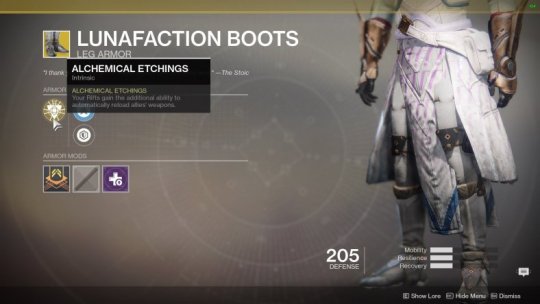
In this manner, you'll get ideas of what you require to contribute to your set and also aid others do the same.
As a result, you're basically beating the purpose of maintaining an emergency supply set to begin with.
Keep a running stock checklist for your emergency food and also water distributions, first aid kit, and various other supplies.
Choose the appropriate kind of emergency situation materials for a friend or family member can be difficult when you may not understand their certain demands which why a present card from EmergencyKits.com make for the perfect gift.
youtube
Where is the best place to keep your family's main emergency kit?
The first thing you'll want to do is divide your content into weights. Place all the heavy items together, the light items together and the mid-weight items together. This will help you pack more efficiently. When you're packing your bag, you'll want to keep heavy items close to your spine and near your hips.
youtube
Ideally, obtain an emergency situation package for your office also. Whether it's a spare bed room, or a closet, or cellar-- make certain that any place you decide to save your emergency products, that you can quickly as well as safely access it at any time. Each house will certainly have specific requirements, but everyone will certainly need to be able to reach emergency supplies. Lastly, list any kind of sort of subject to spoiling miscellaneous products that you might have as a component of your home emergency situation kit. As your living circumstance and/ or household grows or ages, your demands will change too.
Where should I store my bug out bag?
Mayo Clinic suggests that the best place to keep your first aid kit is in the kitchen, where most family activities take place; the bathroom has too much humidity, which shortens the shelf life of items.
Correct Storage of Your Residence Emergency Situation Set
How do you store emergency supplies?
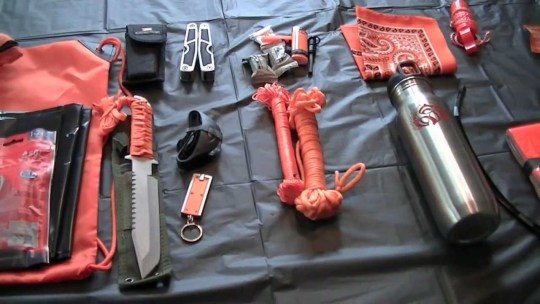
Keep you supplies in a small box or fanny pack. A desk drawer, or storage locker locate near your office or work area is a good place to keep it. Keep a three day supply of food and water in your kit and at a minimum includes these items: flashlight, dust mask, emergency blanket, basic first aid kit.
Mineral water is available in regional discount stores or food store. Get In Touch With the Bottled Waterpublication to find out more about just how to choose a top quality bottled water. As soon as you have actually acquired the bottled water, adhere to step # 3 and also # 4 over.
0 notes
Photo


This semester, Team PREPARE is partnering with On Target Preparedness (OTP) to identify and distinguish access to care barriers and the health care utilization challenges that affect migrant farmworkers in Harnett County. OTP is connected with multiple counties across NC to assist counties in meeting preparedness requirements. They partner with county health departments, state emergency management, volunteer agencies, and individual hospitals to name a few. Migrant farmworkers have specific risks that make them particularly vulnerable when hurricanes strike. These specific risks and access to care barriers include poor housing conditions, lack of knowledge of evacuation and perceptions about shelters. The migrant farmworker population is one of the fastest-growing populations in North Carolina, making NC apart of the 42 states in the US that employ migrant farmworkers.
To help in accomplishing this goal, our group partnered with Team FARMWORKER and their precepting organization, the NC Farmworkers Project, to hold an information fair during a regularly scheduled health clinic. In preparing for this health fair, our team first identified access to care barriers that migrant farmworkers face during hurricanes. Our preceptor, David Hesselmeyer, provided information about how farmworkers feel they cannot seek shelter because of the presence of ICE agents at the shelters and along the evacuation routes. After further research about Hurricane Florence, I found these stories matched up with news articles from last year. When Hurricane Florence hit, ICE agents were deployed to assist in relief efforts. This created a ripple effect of the migrant population refusing to evacuate for fear of deportation knowing ICE agents were waiting where it was safe. There was also fear that using government services like shelters would put their employment status at risk. Many farmworkers lost their lives as a result of this. We knew as a team we had to address this at the health clinic.
In further conversations, Mr. Hesselmeyer pointed me to Emily Watson, another employee with OTP who handles all of the sheltering efforts of OTP. She provided great information that backed up our research as well as gave me more resources to look into such as the FEMA website which had Spanish resources as well. We were able to find hurricane preparedness kit lists which we used to create a skit and take home list for the farmworkers. I also reached out to Anna, the preceptor for Team Farmworker, as well as Nijsha Johnson, an undergraduate student working with the project as well. Anna gave us the idea of the skit as a way to engage the farmworkers and allowing it to put the farmworkers in the shoes of someone who is bracing for a hurricane. She also gave us insight into some of the information we wanted to relay to the farmworkers that were not applicable. For example, we wanted to tell the farmworkers to turn around flood water, not to drive through it. Anna informed us that this wouldn’t help as most farmworkers do not drive themselves, an example of a health care utilization challenge that can affect their health. She was a great community partner to have that has been immersed in the organization and with the farmworkers enough to know valuable knowledge that shaped the poster we presented to them at the clinic. Nijsha played a similar role and helped with translation and provided resources for research such as NC Legal Aid.
For the health fair, we decided to address the three aspects of hurricane readiness that affected access to care: safety, dialing 9-1-1 and preparing a hurricane kit. Our first priority was the overall safety of the farmworkers before, during and after the hurricane. We presented this information through a poster that we displayed at the clinic and playing a game that asked them questions related to hurricane safety. I was surprised to hear all that they knew related to this topic. They were even comical with some of their answers which allowed us to be more comfortable with them and establish a relationship. We had to be flexible by stopping the game in the middle because they were not as engaged with it being the first activity we did. We were thankful to complete the game after the rest of the practicum groups presented and they were even more interactive and playful once they had time to get to know us through the skit and sharing a meal together.
Our second activity was a "scavenger hunt" of items for a hurricane preparedness tote where our team created a tote to show the farmworkers. We hid the items around the room and under chairs while the first game was going on. The activity began by informing them about the importance of having a kit completed before a hurricane and that they were going to help us build our own kit with the items around the room. Then we went down the list one by one and helped them find the items we had scattered around the room. By acting out skits that called for participation, we surpassed the language barrier by using the wonderful Michelle and Andres from Team FARMWORKER as translators, while also giving the farmworkers a chance to put themselves in the situation through the skit that involved them searching for the items in the hurricane kit. This helped address health care utilization challenges by having people that were able to communicate with them in their own language. This information was also given to them through translated brochures for them to take back to their homes, along with toothpaste, toothbrushes and deodorant thanks to our class collection. By the end of the night, most heard this information twice, if not three times to help them remember past the clinic. This also helped them to see the availability of health care systems for them before, during and after the storm so they can better utilize these for the future.
The third activity we prepared was a skit to show them how to dial 9-1-1. While we did not act out this skit, we address how to dial 9-1-1 in one of the questions the farmworkers answered in their game. I also learned from Nijsha another access to care barriers for farmworkers that most do not know their address to tell EMS where they are when they call. Nijsha helped me communicate with the farmworkers how to learn their address and the importance of knowing this information in case of an emergency. Since the farmworkers move in and out based on their seasons of work, this is a common issue that can affect how quickly emergency services can get to them to help in an emergency or hurricane situation. A benefit of them living rurally is that by living in a smaller place, an exact address is not necessarily needed but a general location idea is enough for emergency services to be able to find them. Anna informed me in our meeting that the NC Farmworker Project is working to get the address and directions to the housing of farmworkers posted by the door of each facility so this information is known and easy to access. Emily also agreed with this and also told me that one area that OTP is trying to address related to dialing 9-1-1 is making sure farmworkers know to wait on the phone for a Spanish-speaking operator. This access to care barrier was addressed in our question game since we did not perform the skit for dialing 9-1-1. Even though we did not explicitly perform the skit, the information was conveyed through our game, poster and conversations with the farmworkers.
I consider the health fair to be a great success. We relayed a lot of important information to the farmworkers and we were able to keep them company while they waited in the clinic. One of my favorite parts of the clinic was when one of the farmworker's inadvertently addressed a concept we had learned in class: the causal loop diagram. He talked about the "domino effect" that the farmworkers feel whenever they attend the clinics. First, the NC Farmworker Project gives them transportation to the clinic. When they get to the clinic, the learn information from our presentations on how to live healthier lives. Finally, they are seen by a doctor to help them treat their immediate health needs. I think this perfectly sums up how our practicum group was able to partner with the NC Farmworker Project to bring solutions to a barrier the farmworkers had to health care. I think the partnering of practicum groups with the NC Farmworker Project to present at these health clinics would be a great deliverable for all practicum groups in our programs to complete. Working with them allowed me to see the positive aspect of living in a rural community by having access to nonprofits that can affect health care utilization and address barriers to access. The farmworkers said they never get to see students involved in the clinic like this before. They also loved the company because they are always with the people they work with and alone at night, so it was nice to see other faces. This would also align with the CBPR model of allowing the community and these organizations we are working with at Campbell to come together to impact barriers to healthcare. This also contributed to the success of our fair.
In the future, I would have also liked to act out our skit we prepared for dialing 9-1-1. As the night went on, the farmworkers were getting more anxious about being seen and leaving the clinic as it had been a long day for them and they had been waiting for a while to be seen. Instead of acting out the skit, we asked the whole crowd if they knew how to dial 9-1-1 and they all nodded their head yes. Asking this question this way made it difficult for someone who maybe did not know how to dial 9-1-1 to speak up and say so in front of their peers, so there is a chance they left without ever learning that information. In the future, I would have completed everything we planned to ensure we give everyone an equal opportunity to learn new information.
In conclusion, this fair allowed us to identify access to care barriers to health care for farmworkers including language and lack of knowledge to allow me to meet this rural health competency. We bridged this gap by presenting information at the health fair in their language that included answering questions, disseminating correct information and making the information applicable through involving the farmworkers. We overcame these health care utilization challenges by holding the fair at the clinic where the farm workers were already attending. The created this “domino effect” of providing access to care as well as providing prevention of future care visits in an emergency setting. While there were areas of improvement, this fair was an overall success in recognizing these barriers and challenges and beginning to address those issues.
0 notes
Link
Written by Guest Contributor on The Prepper Journal.
Editor’s Note: This post was contributed by Saqib. If you have information for Preppers that you would like to share and possibly win a $300 Amazon Gift Card to purchase your own prepping supplies, enter today.
Having a child with special needs calls for extra effort and care. You are required to learn a lot, practice an incredible amount of patience and get to know the comfort level of your young one. These are testing times but it is your own loved one at the other corner. It is about being prepared and having your things sorted out well in advance of need and also adequate quantities enough to last. You can just not go haphazardly with these things because it is someone’s life that is right there in your hands.
//
Imagine having someone around with one or more disorders that include being non-verbal, delayed development, epilepsy prone, and an ever-growing diet. In a situation where everything is going down the tubes, there is hope. The amazing and joyful personalities these young ones are inspiring. The fact is that these guys are fighters — surviving more in his short life than most people have to in a lifetime.
So prepping for a child with special needs requires some serious thought, and some creativity. Read the following article, for some tips.
Inventory of Needs
It all starts with some good observation. It is not always that your young one will be speaking telling you what they need, he may not even know what he needs. Hence, it is recommended that you observe. Make a list of things that you consider are essential and can bring comfort. You can have a paper list and stick it on your refrigerator or save one on your mobile or tablet. This can include,
Routine Medicines
First Aid Box
Additional Clothing / Accessories (including diapers, wipes, gloves, wheelchair, stander, walker, etc.)
Medical Supplies (feeding tube supplies, bags, catheters, etc.)
Food Supplements
Communication
There is nothing better than communicating and learning about your child’s needs alongside with making him understand what is good and what is bad and sharing your prepping plans with them. This talking exercise also helps us understand how much the child is grasping, and sometimes that is more than our expectations. The subjects of these talks can be as ordinary as fire escape plans, our family meeting place, why we’re stockpiling certain things, and everything else one can think of. This is crucial. Sometimes simply explaining to the child which floor he lives on and how injurious it could become if he or she jumps out of a window.
Advanced Preparation Saves a Lot
Let’s say you are living in a high-rise building or probably somewhere in open, and are prone to fire or earthquakes. At a time when disaster strikes you can be or cannot be prepared for the emergency. And if you are:

Part of your prepping plans should include alternate transportation ideas like a stroller you can pull behind a bike.
Prepare for the Most Likely Event First
I live in the middle of nowhere surrounded by miles of timber in every direction. Wildfire is the most likely event I should prep for. The odds of having a fire come through my land are greater than other natural disasters.
What event is most likely in your area? If you haven’t yet started getting prepared, prep for that event first. Think through it in your mind, and start gathering what you’ll need.
Start by getting a 3-day supply built up of all your loved one’s essentials. You can look at this like a special bug out bag specifically catered to the needs of your child. It’s a baby step, but an important one.
Medical equipment is heavy. It’s bulky. And it certainly doesn’t move quietly through the woods. Depending on your child’s mobility, leaving home might be very difficult if not impossible.
When you’re making plans for a crisis, you might find it makes more sense to stay put. That way you don’t have to leave all of your equipment and medical stockpiles behind. If we don’t absolutely have to leave the farm, we’re planning on staying here.
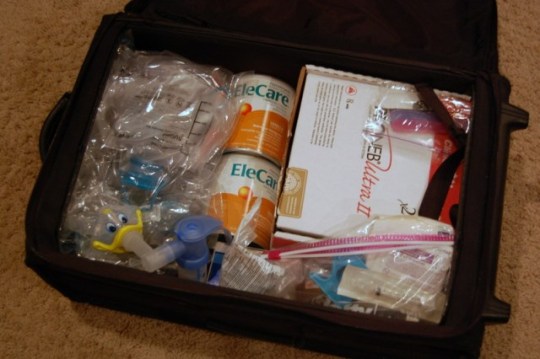
Your child may need more supplies than the average person, but take this into account with packing and adjust your plans.
Storing the Right Things
It is not about just stock piling everything that you get your hand on. It is about stock piling the right things and making sure that your supplies are always refilled, and machines re-calibrated. There are ways that you can stockpile the medications your child needs. This again involves keeping a track of history and making a list. Make sure that when you are stock piling there are no expired medications in your cupboard. An essential to stock are baby wipes. These are very much-needed and at times running short of these can cause real-time havoc.
Learn Alternatives to Medication
Before you can think about replacing a medication, you have to know what it does. Ensure that you know the purpose behind every drug your loved one takes. You can see if there are over-the-counter medications that might work in a pinch as an alternative.
When you can no longer pick up medications, take an inventory of everything you have and see how many doses that is. Then, work backwards to slowly cut the doses down. That way instead of going from a full dose to nothing when you run out, you already have a plan in place for stepping off the med.
Author Bio: Saqib Khan, is an inquisitive blogger and loves to spread his knowledge. With a penchant for medical innovations and developments, Saqib’s new field of interest is herbal medicines. He is currently associated with a top online medical pharmacy in Pakistan offering variety of Pathological & Herbal Medicines such as flu medicine, first aid kits, cough medicine, etc.
If you liked this article, please rate it.
How did you like this article?
The post 6 Essentials for Prepping with a Special Needs Child appeared first on The Prepper Journal.
from The Prepper Journal
Don't forget to visit the store and pick up some gear at The COR Outfitters. How prepared are you for emergencies?
#SurvivalFirestarter #SurvivalBugOutBackpack #PrepperSurvivalPack #SHTFGear #SHTFBag
1 note
·
View note
Text
A Safe Place for Domestic Violence Survivors and Their Pets
The post A Safe Place for Domestic Violence Survivors and Their Pets by Sandy Robins appeared first on Catster. Copying over entire articles infringes on copyright laws. You may not be aware of it, but all of these articles were assigned, contracted and paid for, so they aren't considered public domain. However, we appreciate that you like the article and would love it if you continued sharing just the first paragraph of an article, then linking out to the rest of the piece on Catster.com.
It’s a sad reality that any member of a household can become a victim of domestic violence, even the family cat. And, because abusers are well aware of the bond between their victims and their fur kids, they often exploit that bond to control and punish their victims. And even kill.
Here is the dark truth: In a variety of surveys of domestic violence survivors, between 49 percent and 86 percent reported that their pets had been threatened, harmed or killed by their partners.
Even though intake interviews at domestic violence shelters do not routinely ask about pets, in a national survey, 85 percent of domestic violence shelters indicated that women coming to their facilities spoke of incidents of pet abuse.
Currently, less than 10 percent of shelters have any provisions for pets to stay with their families or be kept safe until they can be reunited.
Kyle the Cat
An internet feline favorite, Kyle witnessed the murder of one of his pet parents, was held as police “evidence” until the case came to trial, and then was turned over to a shelter for adoption. And that’s where Jen Rice found him and gave him a forever home. She created an Instagram account for Kyle to highlight the issue of domestic violence.
Although Kyle passed away in 2017 after having spent seven-and-a-half years living with Jen surrounded by love and care, she continues to work tirelessly in his memory to draw much-needed attention to this problem that often exists under a veil of silence in many homes.
“We think he was abused, too,” Jen says. “He had a wonky ear, and flinched and mewed every time I tried to pet him and show him physical love and affection.
“I loved Kyle unconditionally and he meant so much to me. When I became aware that he was a survivor of domestic violence, I educated myself on the facts associated with pets and domestic violence. I was utterly shocked to learn that the majority of domestic violence shelters don’t accept pets. I couldn’t imagine having to choose between my safety and being separated from Kyle and, even worse, leaving Kyle behind in an abusive household. If anything, pets are needed the most during those trying times to provide comfort and distraction.”
Through Kyle’s Instagram page (@mycatkyle), Jen shed light on the fact that domestic violence victims have to make decisions between pets and safety. Learn more at mycatkyle.com.
Urban Resource Institute
The country’s first entirely pet-friendly domestic violence shelter opened its doors in Brooklyn, New York, last October. It’s specifically designed for survivors and their pets to live together and seek solace from abuse. The seven-story building is outfitted with 30 one- and two-bedroom apartments, where up to 100 people can heal together in safety. The shelter also includes dedicated spaces for pet grooming and play, and offers unique animal-centric programming to help residents of all species thrive.
The shelter is run by Urban Resource Institute (URI), the largest provider of domestic violence shelter and support services in the United States. In 2013, URI established the PALS (People and Animals Living Safely) Program and subsequently began retrofitting existing URI shelters with pet-friendly elements. The program now has six facilities in Manhattan.
They have had huge support from the Nestlé Purina Pet Care Company, which not only contributed to the construction of dog parks in the facilities but also provided food and welcome kits for all resident with pets. For more information, visit urinyc.org.
A cat owner spending time with her cat in the shelter. Courtesy Bayer
Noah’s Animal House
For more than 10 years, pharmaceutical company Bayer, known for a variety of flea and tick medications, has supported an organization called Noah’s Animal House (noahsanimalhouse.org), a full-service boarding facility on the grounds of The Shade Tree Shelter, the largest women’s and children’s shelter in Las Vegas. With Bayer’s help, Noah’s Animal House recently opened a second pet shelter on-site alongside a domestic violence shelter in Reno.
According to Staci Columbo Alonso, founder of Noah’s Animal House, since the founding of her organization, more than 1,600 pets have been housed close to their families so that they have access to their beloved pets.
Cats being cared for at Noah’s Animal house. Courtesy Bayer
RedRover
Purina has also joined forces with RedRover, an organization that provides temporary emergency sheltering, resources, financial assistance and emotional support when animals and people are in crisis. Through an initiative called The Purple Leash, the company is committed to giving more than $500,000 in grants to keep pets and people safely together while escaping domestic abuse. (The color purple designates Domestic Violence Month, which draws attention to this issue annually in October.) Grants available from RedRover include:
Safe Housing on-site grants enable domestic violence shelters to create space for pets to live on-site with their owners.
Safe Housing startup grants allow domestic violence shelters to create their own program to help victims of domestic violence and their pets escape together.
Safe Housing off-site grants enable domestic violence shelters to partner with another local organization, such as an animal shelter or rescue sanctuary, to build housing at their facility specifically for animals whose owners are staying at the domestic violence shelter.
Safe Escape Grants help offset the cost of temporary pet boarding while a domestic violence survivor is at a domestic violence shelter — up to 90 days.
Learn more about RedRover and these grants at redrover.org
Grants Fur Families
Bayer also launched this initiative whereby 13 domestic violence shelters in various parts of the country will receive approximately $10,000 each to help support survivors and their pets by improving their existing pet-related facilities or open on-site pet facilities for the first time. Learn more by following @Bayer4Pets on Instagram and Twitter.
The PAWS Act — Pet and Women Safety Act
Last December, President Trump signed the provisions of the Pet and Women Safety (PAWS) Act into law as part of the 2018 Farm Bill. The PAWS Act establishes a federal grant program for entities that provide shelter and housing assistance for domestic violence survivors to enable them to better meet the housing needs of survivors with pets.
The new law also takes the important step of including pets, service and emotional support animals, and horses in federal law pertaining to interstate stalking, protection order violations and restitution. These provisions provide law enforcement with additional tools for protecting victims from their abusers.
#pawsforthiscause So what can YOU do?
Work with domestic violence shelters in your area to make them aware of the various financial aid options available to them to assist residents with pets.
If you are planning to donate your car to an organization, a victim of domestic violence could be a well-deserving recipient. When victims leave an abusive situation, they often do not have their own transportation.
Offer your services to foster a pet if a shelter doesn’t have any provisions for pets.
Share the video on domestic violence created by Bayer at petandwomensafety.com. Use hashtags #GrantsFurFamilies and #GivingTuesday.
If you know someone who needs immediate help, call the National Domestic Violence Hotline 24/7 at 800-799-SAFE (7233).
Thumbnail: Courtesy Jen Rice
About the author:
Sandy Robins is an award-winning, multimedia pet lifestyle expert, author and pet industry personality. Her feline muses, Ziggy and Tory, like to disrupt the workflow by demanding games of fetch with wand toys and directing food operations in the kitchen. Learn more about Sandy at sandyrobinsonline.com.
Learn more about Cat adoption on catster.com:
Cat Adoption Checklist: Are You Really Ready for Cat Adoption?
7 Tips on Cat Adoption
The Catty Wagon — A Custom-Built Mobile Adoption Vehicle
The post A Safe Place for Domestic Violence Survivors and Their Pets by Sandy Robins appeared first on Catster. Copying over entire articles infringes on copyright laws. You may not be aware of it, but all of these articles were assigned, contracted and paid for, so they aren't considered public domain. However, we appreciate that you like the article and would love it if you continued sharing just the first paragraph of an article, then linking out to the rest of the piece on Catster.com.
from Catster https://www.catster.com/adoption/a-safe-place-for-domestic-violence-survivors-and-their-pets
via IFTTT
0 notes
Link
http://ift.tt/eA8V8J
** TLDR: the opioid epidemic is engineered to make profits for big pharma. Their pain pills cause opioid addiction. Then they conspired to increase the price of naloxone and lobby for the gov to buy the drug. Naloxone is the drug that stops overdoses. **
Six pharmaceutical executives who worked for fentanyl company Insys Therapeutics, including a former CEO, were arrested on Thursday and charged with leading a nationwide conspiracy to defraud insurance companies and bribe doctors to prescribe their powerful and addictive opioid painkiller, according to an indictment from the U.S. Attorney’s Office in the District of Massachusetts. http://ift.tt/2hd1Gae
This relates to an issue Bernie was worried about in 2015:
Sen. Bernie Sanders (I-Vt.) is calling on state governments to work to lower the price of a drug used to treat heroin overdoes.
The liberal presidential candidate challenging Hillary Clinton has joined Rep. Elijah Cummings (D-Md.), the top Democrat on the House Oversight Committee, in pressing for action in what they say is a public health emergency.
“The opioid abuse epidemic is a public health emergency that must be addressed, and no company should jeopardize the progress many states have made in tackling this emergency by overcharging for a critically important drug like naloxone,” the lawmakers wrote http://ift.tt/1O67Tfb
There seems to be money flowing into the Clinton Foundation from big pharma. The CEOs are donating to Hillary's campaign. On the campaign trail I've seen Bill Clinton name drop the drug naloxone. The recent emails on wikileaks confirms that the one of the goals of the Clinton Foundation is to make this drug be everywhere. One of the manufactures of this drug is Hospira, a company recently bought by Pfizer.
Naloxone’s rise to prominence has been good for its manufacturers, Amphastar Pharmaceuticals and Pfizer PFE -0.06% , which both doubled the price over the past two years. (Three other companies, Mylan MYL -2.65% , Kaléo, and Adapt Pharma, also recently entered the market.) But more significant: It saved 8,000 people from an overdose last year—a number that’s growing fast. http://ift.tt/1QcU1E3
There seems to be serious conflicts on interest. been the campaign and the companies. For example Clinton wants to give these campaigns 7.5 billion dollars through federal programs. This is an OP-Ed from Hillary from last year:
Today I’m releasing a strategy to confront the drug and alcohol addiction crisis. My plan sets five goals: empower communities to prevent drug use among teenagers; ensure every person suffering from addiction can obtain comprehensive treatment; ensure that all first responders carry naloxone, which can stop overdoses from becoming fatal; require health care providers to receive training in recognizing substance use disorders and to consult a prescription drug monitoring program before prescribing controlled substances; and prioritize treatment over prison for low-level and nonviolent drug offenders, so we can end the era of mass incarceration. http://ift.tt/1hUkub9
Despite the drug not being under patent, there is still a virtual monopoly on the manufacturing of the drug. The allows the 2 or 3 companies making the drug to raise praises for no reason
In an emailed statement today, Amphastar CFO Bill Peters said, the company's price for naloxone was less than competitors.
"Indeed, our price for naloxone after the increase is still the lowest among similar products in the United States. The fact that we have the lowest naloxone price is all the more remarkable because it is sold in a pre-filled syringe associated with a higher manufacturing cost. On average, the price of naloxone in the U.S. market (in vial form) is $37.23 per milligram, or 226% of the price of Amphastar's naloxone (in a prefilled syringe) when considering the price per milligram of naloxone. With all of this in mind, I am confident that we can assist Ohio in a similar way that we did with New York as we are committed to public safety."
In making his request, DeWine pointed to $6-per-dose rebate that Amphastar this month agreed to pay back to New York, an agreement that also protects the state against wholesale price increases for a year. According to The New York Times, that rebate was sought after police departments in the state, as well as across the country, began complaining that price increases were limiting their ability to save lives. In Georgia, for one, the price rose from about $20 a dose to $35 to $40 a dose. Health officials in Baltimore have been handing out kits containing naloxone to relatives and friends of people where there were concerns of overdoses but has had to limit that to 2,000 from 3,600 in the face of price increases.
The company, which went public last year, reported 9-month revenues of about $155 million and an operating loss of nearly $11 million for three quarters. It did not break out sales of naloxone in its last filing but said the drug was having "increased sales." Amphastar is not the only company to be caught in the cross-hairs of public sentiment for raising prices of the overdose drug. The Clinton Foundation last month said it had negotiated a discount with Kaléo for the naloxone autoinjector it makes. Rain Henderson, CEO of the Clinton Health Matters Initiative, wouldn't name the price but told the Times it would make it available to any institution that can distribute it widely. The foundation has approached other naloxone makers but Kaléo was the first to respond.
http://ift.tt/1Ujql9M
Clinton seems more concerned about providing drugs to treat overdoses, rather than combating the over use of opioids in the US medical system or seriously helping people battling addiction.
What is interesting about her plan to make naloxone widespread, is that it lines the pockets of her donors, while reducing the number of deaths from overdoses. This plan could change this statistic, without changing the number of addicts in various communities. It wouldn't solve an addicts problems, just makes their habits less deadly.
I was wondering if if someone here with more experience at looking at campaign donations could find anything illegal. It seems highly suspicious to me that you can take millions of dollars of money from companies, and then name drop their products in Op-eds and speeches while campaigning. There are different ways this problem could be solved, such as developing non-addictive pain medication. However, a Clinton administration and the Clinton foundation want to push a band-aid solution on this opioid addiction epidemic; this of course increases the money that flows into their donor's pockets. I think this is one of the easiest cases of Clinton being influenced by campaign contributions and Clinton Foundation donations.
I've continued to dig and I have found something extremely interesting. I was having trouble linking Hillary Clinton to the Pfizer's Super Pac, but Pfizer has been extremely active this year, giving thousands of dollars to Democrats. I started to cross reference the Democrats they give money too with the list of Democratic Ssuperdelegates. Here are the links I'm using: Pzifer's PAC: http://ift.tt/1SNTKq2
Hospira Inc's PAC (they are owned by Pzifer: http://ift.tt/1SwUjG4
http://ift.tt/1MOH6Rk
It appears that Pfizer gives money to superdelegates who then pledge their vote to Hillary. I think there needs to be some serious analysis of the money going to superdegelates; it is probably far more cost effective to get a candidate via superdegelates than it is to donated to Hillary directly.
Update:
The access of this drug is now being more widely available, in Florida for example:
First responders in Florida have administered naloxone for years. But under a measure approved by the Legislature this year, patients and their families can now quickly get the drug from a pharmacy. Naloxone, sold under the brand name Narcan, isn't available over the counter. But patients and their families no longer have to get an individual prescription from a doctor to access the drug. Instead, they can purchase an autoinjector or intranasal version of naloxone through their pharmacists if the pharmacy receives a so-called blanket "standing order" from a doctor. "This gives better access to patients who didn't have that access before," said Michael Jackson, executive vice president and CEO of the Florida Pharmacy Association. "This medication can save lives." http://ift.tt/2apM0v8
At the DNC it was even talked about: https://youtu.be/_yK8PPYsBJM?t=203
At the DNC they drop the name Narcan. If Hilllary becomes president watch the price of this drug skyrocket further!
Some Senators are fighting this crony-capitalism. Asking why there is a 17-fold increase in the price of some versions of this drug. http://ift.tt/2auDYB2
“One concern is that money for naloxone is coming out of the same pot as money for treatment and prevention,” Alison Knopf, editor of Alcoholism & Drug Abuse Weekly. “The costlier it is, the less money for treatment and prevention.” Meanwhile, last February, Kaleo Pharma raised the list price for two single-dose injectors to $3,750, from $750, a price that was set last November, after previously costing $575, according to Truven.
http://ift.tt/2a36uau
Current price for two does is about $140, it used to be $4: http://ift.tt/2auEH89
WIKILEAKS EMAILS SUPPORTS THIS CONSPIRACY The CHIA is getting narcan in highschools, because people overdose on heroin at highschools all the time!
· In continuing coverage of Adapt Pharma and CHMI’s collaboration to offer a free carton of Narcan, a nasal spray that quickly reverses heroin overdose, to all high schools in the U.S., the Philadelphia Inquirerhttp://ift.tt/2dPEXNx, Lancaster Onlinehttp://ift.tt/1RVZAYi, NBC 10http://ift.tt/2dPEKtM, and NJ.comhttp://ift.tt/20neNX8 wrote about how Pennsylvania will be the first state to supply the live-saving antidote.
http://ift.tt/2ekNomz
This aligns with YOUR goal that naloxone be in the toolkit of all first responders Attorney General Healey has expressed concern about the cost of naloxone, and indicated interest in meeting with pharmaceutical companies and public health leaders to push for cheaper nasal naloxone products and to ensure first responders can restock supplies of the medicine.
· Naloxone: YOU set a goal that naloxone, a rescue drug that can prevent overdoses from being fatal, be in the toolkit of all first responders.
On Tuesday September 29, Governor Hassan and state officials gathered to announce a new program in New Hampshire to hand out free naloxone kits –the opioid antidote that can prevent an overdose from becoming fatal – to families and friends of people at risk of an overdose. The New Hampshire legislature recently passed a bill to exempt people from criminal prosecution if they report an overdose and make it easier for the patient to take naloxone, and Governor Hassan is now building an awareness campaign. YOU could mention that you are aware of New Hampshire’s recent decision to expand access to naloxone, and that YOU want it to be more widely available in all states. http://ift.tt/2ekNomz
They stated that they want to have naloxone everywhere. They don't want to treat addiction, they want to profit off of it! How much money? Up to a $ 1 Billion dollars!
Fortunately, President Obama understands this -- that's why he is proposing to set aside $1 billion in his budget proposal to address the opioid crisis. Senator Shaheen had earlier this year introduced a bill that I cosponsored calling for $600 million in additional spending for states. http://ift.tt/2d8z7EF
This is already passed:
The VA must: (1) maximize the availability to veterans of opioid overdose reversal drugs, such as naloxone; (2) equip each VA pharmacy with such medications for outpatient use; and (3) expand the Overdose Education and Naloxone Distribution program to ensure that veterans receiving VA health care who are at risk of opioid overdose may access such drugs and training on the proper administration of such drugs....
Good Samaritan Assessment Act of 2016 (Sec. 503) The GAO must report on the Office of National Drug Control Policy's review of state and local Good Samaritan laws that exempt from criminal or civil liability any individual who administers an opioid overdose reversal drug or device (e.g., naloxone) or who contacts emergency services providers in response to an overdose.....
Co-Prescribing to Reduce Overdoses Act of 2016 (Sec. 902) HHS may establish a grant program to support prescribing opioid overdose reversal drugs (e.g., naloxone) for patients at an elevated risk of overdose, including patients prescribed an opioid. Grant recipients may use the funds to purchase opioid overdose reversal drugs, establish a program for prescribing such drugs, train health care providers and pharmacists, track patients and outcomes, offset patient cost sharing, conduct community outreach, and connect patients to treatment.
Lali's Law (Sec. 1302) HHS may make grants to states that allow standing orders (documents that allow a person to acquire, dispense, or administer a prescription medication without a person-specific prescription) for opioid overdose reversal drugs (e.g., naloxone). Grants may be used for:
*developing standing orders for opioid overdose reversal drugs for pharmacies,
encouraging pharmacies to dispense drugs pursuant to such a standing order,implementing best practices for prescribing opioids and prescribing and discussing with patients opioid overdose reversal drugs,
*developing training for prescribers to use in educating the public on administration of opioid overdose reversal drugs, and
*educating the public on the availability and public health benefits of opioid overdose reversal drugs. http://ift.tt/1YM6mBs
More and more laws are being are being written to push the drug naloxone. Like this one sponsored by Hillary's running mate Tim Kaine:
(Sec. 2) This bill requires the Department of Health and Human Services to provide information to certain prescribers on best practices for prescribing naloxone for patients receiving chronic opioid therapy or being treated for opioid use disorders. (Naloxone is a prescription drug used to rapidly reverse an overdose of opioids, which are drugs with effects similar to opium, such as heroin and certain pain medications.) The information must be provided to prescribers in federally qualified health centers and the health care facilities of the Indian Health Service. http://ift.tt/2d8zvDa
https://twitter.com/timkaine/status/731501659998687232
The compromise legislation also includes language to encourage naloxone co-prescribing in federal health settings. Kaine authored the Co-prescribing Saves Lives Act, a bipartisan bill that would encourage physicians to co-prescribe the life-saving drug Naloxone alongside opioid prescriptions and would make it more widely available in federal health settings. http://ift.tt/29Pmj8u
Ten days after posting this, Kaine became Hillary's VP.
This move will allow the manufacturers of narcan to make huge amounts of money for decades to come due to the constant "need" to replace expired drugs for first responders around the country:
According to one report, Baltimore spent $118,236 on naloxone in fiscal year 2016, more than triple the $33,540 the city spent in 2014...
In a rush to head of a growing epidemic of fatal opioid overdoses, many state and local government tapped into emergency funds to get naloxone to their first responders. Or else they took advantage of limited-run programs like the federal government’s Rural Opioid Overdose Reversal Grant Program, which distributed just $1.5 million to 15 communities....
The Department of Health and Human Services announced at the end of August that it will provide up to $11 million to fund the purchase and distribution of naloxone, but only a dozen states will see any of that money....
But naloxone doesn’t last long. In May, the county had to destroy half of its remaining naloxone stores—about 200 of the 900 kits it originally purchased in 2014 from Amphastar—because they had expired.....
A number of other police departments rely on money seized during drug investigations to fund their naloxone programs. And in July, a judge in Pittsburgh took the unusual step of requiring two convicted drug dealers to shell over nearly $4,000 to pay for naloxone. http://ift.tt/2cbLwtU
It used to be sold as low as $4, and several politicians are complaining about the recent price hikes. Small companies that make the drug get bought by bigger companies (look at Pfizer purchasing Hospira).
As of October 2014 — the most recent time for which prices are available — Hospira's version of naloxone was $15.80 a dose. That's up from $0.92 a dose in 2005, according to Truven Health Analytics. The price of Hospira's version of naloxone hit a peak of $21.90 a dose in January 2014. Pfizer purchased Hospira last year.
Meanwhile, Kaléo has raised the price of its naloxone product, Evzio, several times since last year. In November 2015, the price went up to $375, followed by an increase to $1,875 in February 2016. Since then, the price has been raised to $2,250 for each single-dose injector. Evzio, which is an auto-injector that works like an EpiPen and is specifically created for use by people without medical training, was introduced at $287.50 for each single-dose injector in July 2014, according to Truven....
The price increases, combined with the increase in demand, have caused sales of naloxone to jump from $21.3 million in 2011 to $81.9 million last year, according to numbers from prescription-tracking company IMS Health and cited by The Los Angeles Times.
Amphastar, one of the two producers of the lower-priced injectable naloxone, saw a revenue increase of 4% in the first quarter of 2016 compared with the first quarter of 2015, according to a press release. The company attributed that increase largely "to an increase in sales of naloxone to $10.3 million from $6.7 million." http://ift.tt/2alVrMK
Unless this issue get more publicity the trend for this will continue. This will mean less people will get the drug, and more tax-payer money will line the pockets of private companies. The companies are exploited a high demand, with cartel like behavior. The extreme price hikes suggest this has nothing to do with the cost of production. Other countries negotiate drug prices, why can't we?
Hillary even talks about her $10 billion plan, which includes buying lots of narcan (naloxone)
Today, Hillary Clinton is making clear that this deadly epidemic of addiction must be addressed head-on and is proposing a bold proposal to do so. Her $10 billion Initiative to Combat America’s Deadly Epidemic of Drug and Alcohol Addiction sets forth ambitious goals to prevent and treat substance use disorders, and to support people in recovery....
First-Response: Create a state fund to help police, fire departments, and EMTs purchase naloxone; and create naloxone training programs for first responders. http://ift.tt/1RE2xgh
Clinton would also boost evidence-based prevention programs in schools and make naloxone, the overdose reversal drug, more widely available. Some states have already made naloxone available over the counter so family members and friends of addicts can purchase it. She's also stressed a need to improve and integrate mental health and substance abuse care, as the two often occur together. http://ift.tt/2dhs27W
Recently Propagandist John Oliver got in on this: https://www.youtube.com/watch?v=5pdPrQFjo2o&feature=youtu.be&t=1048
Update - December 2016 Big-Pharma Executives were arrested for pushing fentanyl!
Six pharmaceutical executives who worked for fentanyl company Insys Therapeutics, including a former CEO, were arrested on Thursday and charged with leading a nationwide conspiracy to defraud insurance companies and bribe doctors to prescribe their powerful and addictive opioid painkiller, according to an indictment from the U.S. Attorney’s Office in the District of Massachusetts.
In order to get doctors to prescribe more fentanyl, the indictment says, Insys executives gave them thinly disguised kickbacks. One of the preferred methods for this was to bring them in to supposedly give paid speeches about their products with other healthcare professionals. But many of the events had no attendees, and sales representatives routinely falsified names of guests, the government claims.
When one of the company’s top prescribing doctors stopped prescribing as much of the potent opioid, one top executive emailed another saying, “we cannot go a single day without a prescription from … [the doctor]. I do not want to hear excuses, we pay good money here,” the court records indicate. http://ift.tt/2hd1Gae
New Update -
Naloxone is most commonly administered by injection or spray. Kaléo, a Virginia company, has increased the price of its naloxone auto-injectors, sold as Evzio, from $690 for a kit of two to $4,500 in less than two years. Amphastar of California nearly tripled the price of syringes pre-filled with naloxone.
“When we started in 1996, a 10cc vial of naloxone was $1.63. Now that 10cc vial is almost $300 at Walgreens here,” said Bigg. “Has the price been raised well beyond what it costs to make in an obscene way for such an important lifesaving drug? Yes.”
Robert Childs, director of the North Carolina Harm Reduction Coalition, one of the largest non-profit distributors of naloxone in the US, said his organisation has spent about $220,000 this year giving out more than 13,000 naloxone kits to police officers and others working with those at risk of overdose.
“If naloxone wasn’t the price it is, we would be able to buy a lot more and get a lot more out there to high-risk populations,” he said. “There’s a public health crisis with opiate and opioid-based drug overdoses, and the response has often been to increase the price which is probably the worst response you can do.”
The increased demand and rising prices has resulted in a surge in income from naloxone for drug companies, up 400% since 2011 to $82m last year. http://ift.tt/2hEWbOH
Remember Kaléo is linked to the Clinton Foundation and Democratic party power structures.
For the first time in American history, median U.S. life expectancy is declining — as a result of opioid addiction. From 2000 to 2015, more than 500,000 persons in the United States died from drug overdoses. These casualty figures not only reflect a national health emergency, but are emblematic of a war on the American people. By comparison, approximately the same number of Americans lost their lives fighting in World War II, Korea and Vietnam — combined. http://ift.tt/2iNDawR
Naloxone has been available since 1971, originally under the brand name Narcan, and now in several generic forms, as well as formulations with new delivery systems. Both categories have their own cost stories; a generic form made by Hospira, now owned by Pfizer, rose in price from less than $1 per milliliter vial in 2005 to more than $15 in 2014. The newer delivery systems range in price from $125 for two doses to as much as $3,750. http://ift.tt/2iORq5Y
Update - More Naloxone in more places.
In response to the exploding opioid epidemic plaguing Mississippi and the nation, grocery retailer Kroger and the state's top drug enforcement officials teamed Thursday to announce eased accessibility to the overdose antidote Naloxone.
John Dowdy, executive director of the Mississippi Bureau of Narcotics, joined with local law enforcement and Kroger representatives to announce the drug will be available without prescription at 29 Kroger pharmacies throughout Mississippi. http://ift.tt/2r0fEQJ
A new state standing order goes into effect June 1 in Baltimore that will expand access to naloxone, a medication that reverses the effects of opioid overdose. And city pharmacists are preparing for the shift.
The move is another step in the effort to reduce opioid deaths in the state and city. Gov. Larry Hogan has declared Maryland's opioid epidemic a state of emergency, after fatal heroin overdoses nearly doubled between January and September 2016 compared to the previous year, and fentanyl deaths quadrupled. In total, deaths from these two opioid drugs spiked to 1,656. In March, Hogan signed an executive order for $50 million in new funding to go toward addressing the crisis. http://ift.tt/2quZ6gl
Each formulation of naloxone — two injection doses, Narcan nasal spray, and Evzio auto-injector — essentially has one supplier. Though there are three manufacturers with FDA approval for 0.4-mg-per-milliliter-dose injections, the vast majority are sold by Hospira, which has increased the price by 129% since 2012 (see table). Only Amphastar manufactures 1-mg-per-milliliter injections, the dose used off-label as a nasal spray, which currently costs $39.60 after a 95% increase in September 2014. Newer, easier-to-use formulations are even more expensive. Narcan costs $150 for two nasal-spray doses. A two-dose Evzio package was priced at $690 in 2014 but is $4,500 today, a price increase of more than 500% in just over 2 years. http://ift.tt/2gLgmc8
Called Evzio, it is used to deliver naloxone, a life-saving antidote to overdoses of opioids. More than 33,000 people are believed to have died from such overdoses in 2015. And as demand for Kaleo’s product has grown, the privately held firm has raised its twin-pack price to $4,500, from $690 in 2014. http://ift.tt/2kviZEP
submitted by /u/9kokonotsu
[link] [comments]
May 28, 2017 at 10:05AM
http://ift.tt/2s9eqAp
from /u/9kokonotsu
http://ift.tt/2s9eqAp
0 notes